Annual Review 2020/21 – We are Sellafield Ltd
Published 25 August 2021
1. Letter from the Chief Executive
When I took over the role as Chief Executive in early 2020, a pandemic wasn’t one of the things that I thought we would be tackling.
Despite the unpredictable and unprecedented nature of COVID-19, I am proud of the way all of our employees and supply chain partners responded.
It has been a challenging year and, inevitably, the pandemic did have an impact on our work. We stopped all of our nuclear operations for 6 weeks when the country entered the first national lockdown, bringing work back online as we had the confidence to do so.
Throughout we kept the site safe and secure and did make some progress towards our purpose of creating a clean and safe environment for future generations, and we supported our communities.
Throughout this report you will read about our successes and achievements not from me, but from the people who delivered them as they share their proudest moments.
I’ve spent time with as many teams as possible across the site and across our organisation this year. I’m always struck by the passion, pride and enthusiasm teams and individuals have for their role and so I am delighted that they get to tell their stories in these pages.
Our work continued at Sellafield this year, albeit in more challenging circumstances. We pushed ahead with what is arguably one of the biggest major construction project portfolios in the country – a key step towards being able to empty our highest hazards, the legacy ponds and silos.
We also published our enterprise strategy for Sellafield Ltd and our manifesto. Together these documents provide real clarity for our internal and external stakeholders.
They set out what we are going to do at Sellafield and how we will work to deliver our purpose. You can read about both of these key documents further down this document.
The latter document was a source of pride for me this year. Our manifesto sets out the behaviours we expect of each other. Crucially that simple, one-page document wasn’t written by me, by our board or our executive. It was written by more than 400 of our employees.
It is their vision of the kind of organisation we want to be.
I look forward to leading the organisation in the coming year as we take our next step toward achieving that vision.
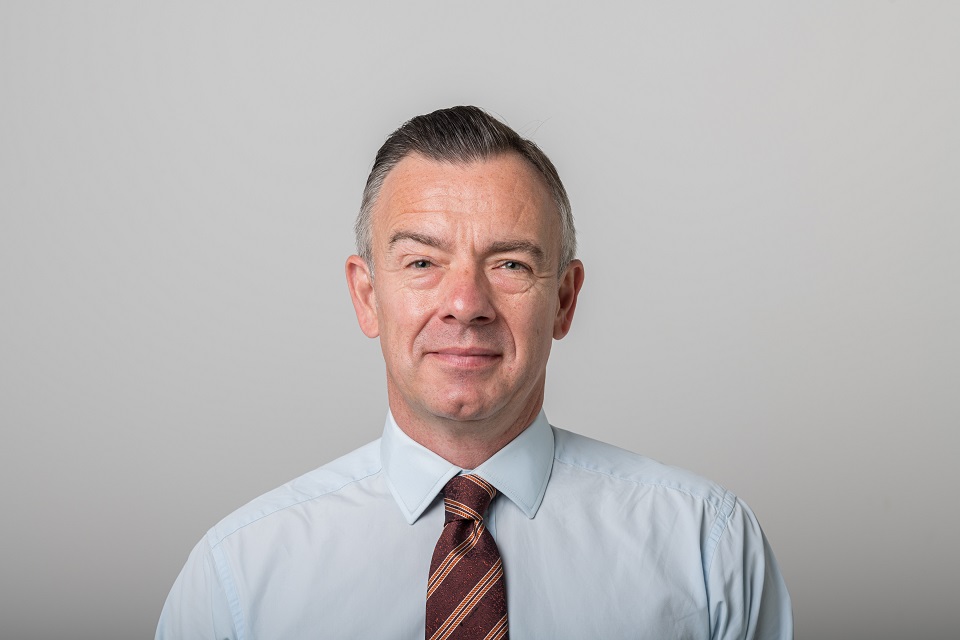
Martin Chown Chief Executive Officer
This year we have worked with our BAME network to introduce reverse mentoring for the executive team. My reverse mentor is Joseph Ghayouba.

Martin Chown (left) and Joseph Ghayouba (right).
Although still in relatively early days of our work together I have already learned a lot from him and look forward to continuing to sharing our ideas and experiences this year.
For more on reverse mentoring, please see check further down this document.
2. 2020/21 at a glance
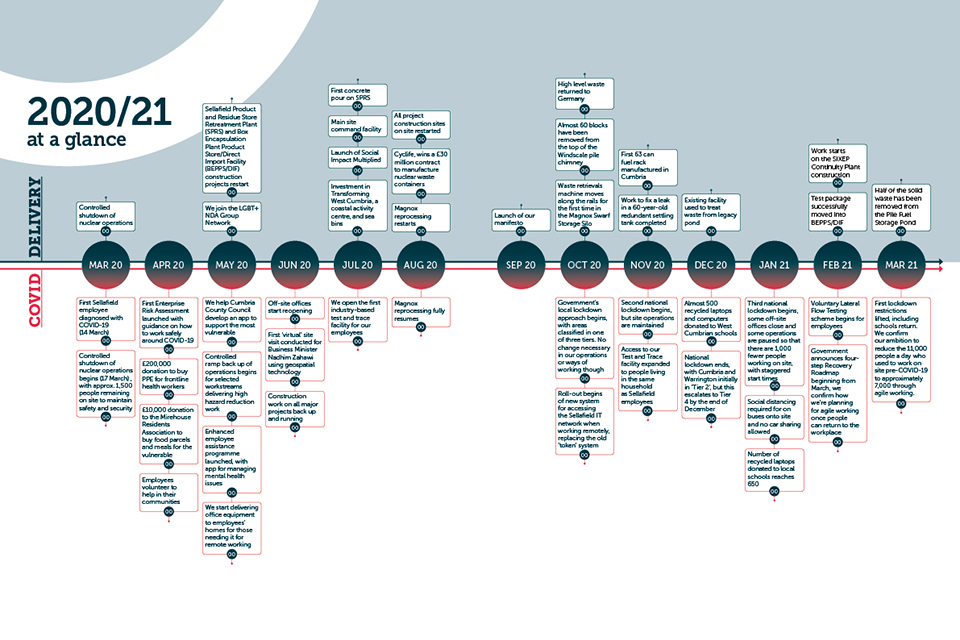
My name is Kathryn McCloghrie and I joined the organisation in 2005.
Today I am the head of enterprise strategy and for some years I have also been the chief of staff for our crisis management support team.

The team are volunteers from all areas of the enterprise who are available on a best endeavours basis to support the executive crisis management team to manage off-normal situations which challenge the enterprise.
We decided in February to bring some of that team together to do some preparatory work in case the pandemic did challenge us. At that time our focus was on maintaining safety and security if a substantial proportion of our people were ill and couldn’t work.
We needed to be ahead of the pandemic, running things down in a controlled way in case the absence rates increased quickly.
As it turned out, the impact on our activities was driven by national constraints more than illness rates. Keeping our people informed and supporting everyone was a key priority. We engaged with HR to think through the questions and challenges we anticipated from our people and with our IT teams to prioritise access to remote working.
We were gathering and providing daily reporting to NDA and government to reassure them that the site was being managed safely and securely.
We also worked closely with the Local Resilience Forum to support the wider community and engaged with external specialists to ensure we had the best possible advice to protect our people.
I am so proud of everyone in the support team. Every individual stepped up and delivered beyond my expectations. We looked after each other and supported our contacts across the enterprise.
Last autumn, I was awarded a British Empire Medal, which is something I could never have imagined might happen to me. It is a tribute to the amazing efforts of the team and to the culture of Sellafield Ltd which values us being a vital supportive part of our communities and looking out for each other.
3. Who we are and what we do
In 2020/21 we published our enterprise strategy and manifesto, setting out our objectives for the next 3 to 5 years and the behaviours we expect of each other as we deliver our purpose of creating a clean and safe environment for future generations.
By 2025 we’ll have:
- completed reprocessing and we’ll be cleaning out the buildings
- started to remove waste from our legacy silos
- built a resilient, modern and digitised command capability
- created accommodation that enables a modern working environment
- a roadmap to reduce our carbon footprint
- piloted thermal waste processing
- removed a high risk to the site by demolishing the Windscale chimney
To achieve this while we also transition the organisation from one largely focussed on reprocessing to our new mission of waste management and environmental restoration, we will focus on the following objectives:
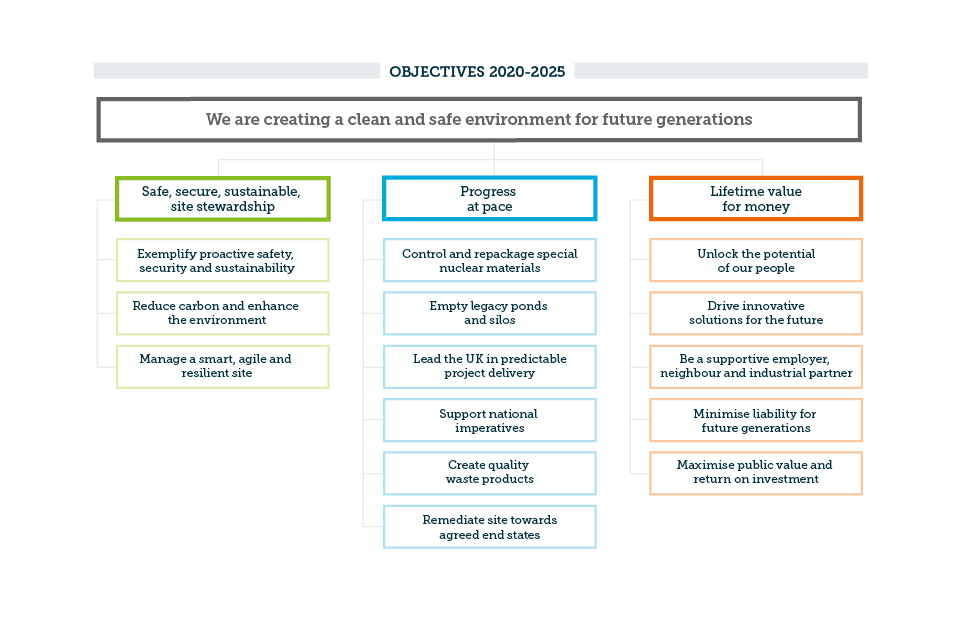
How we’ll do it - our manifesto
Created and launched in 2020/21, our manifesto sets out the organisation that we want to be. The behaviours we want to see. And the clear purpose that we are all working towards.
We are creating a clean and safe environment for future generations.
It was co-created with more than 400 of our employees from across our organisation. Those employees span our locations, our types of work and our pay grades.
The result – our manifesto – is their words.
They helped to define how we describe our purpose.
Perhaps even more importantly, they helped us to define our behaviours, because how we behave sets our standards.
This is the expectation we now all have of each other.
Each part of our manifesto is owned by a member of the executive team, but it belongs to everyone working at Sellafield. This is our manifesto.

Case study - Jan Thompson
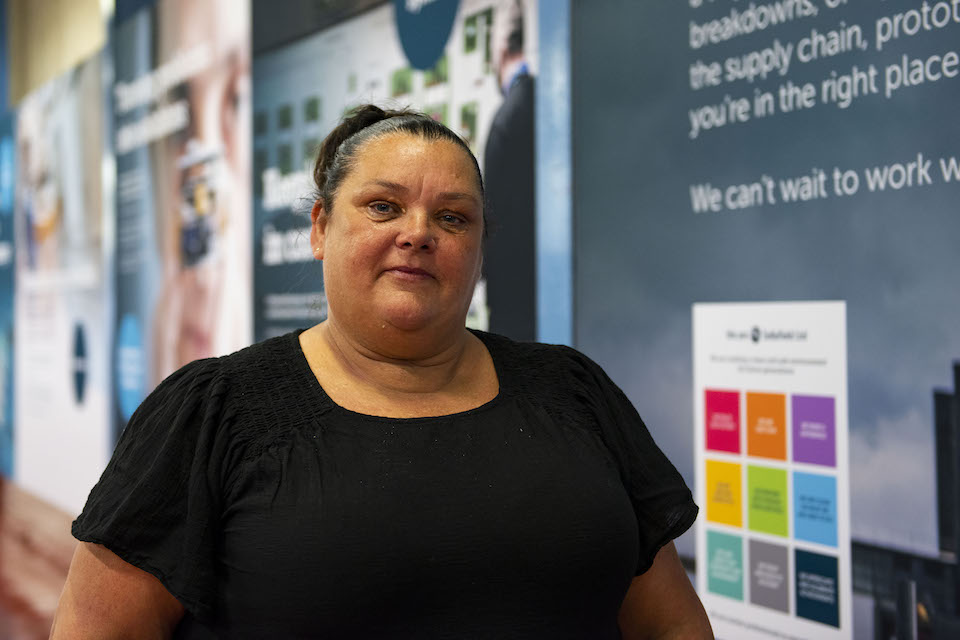
I’m Jan Thompson. I am a technical support SAP demander and have been with the company for 9 years and on the site for 8 years.
This year I was one of the 400+ employees who helped to write our manifesto.
When the email came through inviting me to take part, I thought it had come to the wrong person – why would they want someone of my grade (band five) to join this and help?
I bit the bullet and attended, and what a great choice that was. I was proud to speak up and give a band five/shop floor perspective, to be able to put those views across.
Another highlight for me was telling my story of what the manifesto is and what it means to me to the band 2 and personal contract holder community – the most senior people in the company.
And, lastly, I’m proud of my involvement in the manifesto stand up day we had recently where teams across the company stopped working to talk about the manifesto and what it means to them.
COVID-19 restrictions meant that some of the group discussions were small but it was great to talk to people about it face-to-face. I can’t wait to do more of that. It will be especially rewarding to be able to go and talk with more people who work on plant. To be continued !
4. Supporting national imperatives
Our priority is to safely and securely clean-up the Sellafield site on behalf of the Nuclear Decommissioning Authority (NDA).
In delivering this nationally important work we are also supporting a number of national imperatives.

5. Sellafield Ltd and the NDA – working together to measure progress
The work we do at Sellafield every day is determined by our enterprise strategy which, in turn, is informed by the NDA’s strategy. Teams at Sellafield Ltd and the NDA work closely to ensure that both organisations understand the progress that is being made.
Case study - Simon Clare
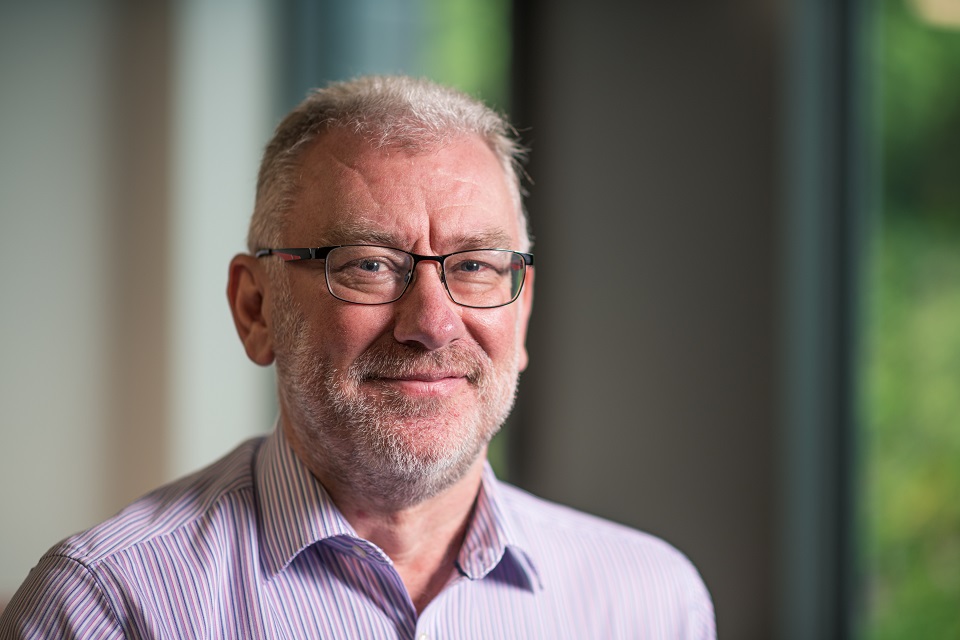
My name is Simon Clare and I am head of performance assurance at Sellafield Ltd. I’ve been with the business for more than 35 years and actually heading into my last year before retirement.
My role is to build stakeholder confidence in Sellafield Ltd and in our ability to deliver our work.
Specifically, that means:
- delivering effective assurance and governance in support of key business decisions and improved delivery through independent challenge. Support and escalation where needed.
- driving a continuous improvement culture and hold the business to account through independent oversight and challenge.
It also means acting as an interface with the NDA commercial team for performance assurance and sanction matters, maintaining a productive and transparent relationship.
This past year has obviously been different to a ‘normal’ year at Sellafield but I’m proud that, as a team, we have maintained and improved delivery of our roles with minimal disruption, having responded positively and quickly to the challenges of the new working environment.
Case study - Paul Touhy
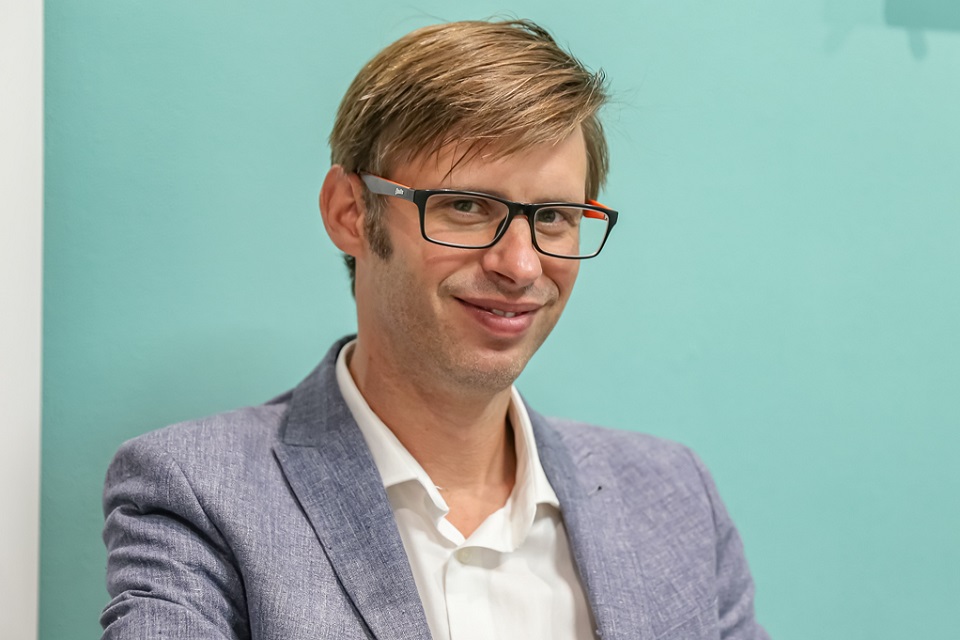
I’m Paul Touhy. I’ve worked for the Nuclear Decommissioning Authority for around 15 months and I’m the head of category for manufactured products and waste services.
I’ve also worked on the ‘other side’ of the team having spent around 12 years at Sellafield.
My role has 2 distinct aspects, firstly the development of NDA Group Category Strategies which demonstrate a deep understanding of how our site licence companies interact with the supply chain for a range of complex products and services.
I then use this information to drive improvement and assure commercial and procurement strategies, ensuring best practice, risk management and innovation are at the heart of what we do.
Secondly, I lead on the relationship with Sellafield’s commercial teams, ensuring that Sellafield and NDA are working together effectively across the entire breadth of activities that Sellafield undertake, and being a point of escalation for issues as they arise.
This involves a broad understanding of the full range of commercial activities that Sellafield undertake, developing close working relationships with a range of individuals across projects, programmes and functions including IPAG (Independent Performance Assurance Group).
The NDA procurement and supply chain team has undergone a significant change to ensure that it has the capability and capacity to understand and assure the huge variety of procurements and contracts the group undertakes.
Most of this recruitment has been undertaken within the pandemic, and therefore people haven’t had the onboarding and support that an office environment brings.
I find it inspiring how so many people, brought in from public and private sectors have risen to the challenge, worked collaboratively and built relationships with colleagues from Sellafield and across the wider group – often never meeting face to face.
6. Delivery against our targets 2020/21
Our annual targets, agreed with our owner the Nuclear Decommissioning Authority, are a key measure of delivery.
Here’s how we performed against those targets in 2020/21.
| Area/value stream | Key targets for 2020//21 | Performance target (good) | Performance YE outturn | ||
|---|---|---|---|---|---|
| Enablers | Corporate | Cost reduction - Operating Plan cost variance (excludes 4 Project Delivery Directorate projects) | 377 | 270 | |
| Function and transformation | Approval of the human resource Strategic Capability Plan and associated implementation plan aligned with the revised enterprise strategy | 28 Feb 2021 | 18 Dec 2020 | ||
| IT replacement and improvement – delivery of tranche 1 service transitions and procurements | 30 Jan 2021 | 01 Jun 2021 | |||
| Technology development programme milestones – delivery of demonstrable progress on new capability development (%) | 80 | 40 | |||
| ES&S | Environment, safety and security | Operational readiness for command transition start | 30 Sept 2020 | Not yet achieved | |
| Optimise Sellafield Ltd’s need to progress High Hazard Risk Reduction and UK’s 2050 net zero target for greenhouse gas emissions | 4 | 5 | |||
| Site Management | Site Management | Critical asset maintenance strategy development and implementation (%) | 75 | 92 | |
| Value Streams | Retrievals | X units of inventory removed from the Legacy Ponds; First Generation Magnox Storage Pond and Pile Fuel Storage Pond | 668 | 385 | |
| Magnox Swarf Storage Silo basket of measures | 2.5 | 0 | |||
| Spent Fuel Management | Waste Vitrification Plant throughput – vitrification of highly active liquor – volume reduction | 160 | 63 | ||
| Magnox Reprocessing | 380 | 137 | |||
| Achievement of targets requires the reprocessing of Dounreay fast breeder reactor fuel | 3.3 | 4 | |||
| Special Nuclear Materials | Material package integrity recovery programme - type 1 overpack throughput (cumulative) | 178 | 187 | ||
| Remediation | Pile 1 chimney diffuser seismic risk reduction - cumulative height reduction of 12.4 metres | 27 Nov 2020 | 30 Oct 2020 | ||
| Project Delivery | Box Encapsulation Plant and Product Store Direct Inlet Facility – complete inactive commissioning | 31 Dec 2020 | 25 Apr 2022 | ||
| Demonstrate the maturity of the programme and project partners for successful delivery of the longer term critical success factors | 4 | 3 | |||
| Maximise strategic value through implementation of Joint NDA/Sellafield Ltd project and programme review actions | 4 | 3 | |||
| Performance modifiers | Corporate | Business performance (positive cost variance) | ≥ £300 million | 225 | |
| Functions and transformation | Implement new 4-year diversity and inclusion strategy with supporting improvement and implementation plans | 31 Mar 2021 | 19 Jan 2021 | ||
| Supply chain – small to medium sized enterprise (SME) agenda – achievement of Her Majesty’s Government SME spend targets (%) | 32 | 28 | |||
| Environment, safety and security | Personal contamination events | ≤ 15 | 11 | ||
| Environmental non-compliances | ≤ 18 | - | 17 | ||
| Nuclear Sellafield Incident Report | ≤ 2 | - | 1 | ||
| Total recordable injury rate | ≤ 0.29 | - | 0.22 | ||
| Security breaches | ≤ 160 | - | 164 | ||
| Achievement of Sellafield Ltd Operating Plan milestones (%) | - | 85% | 96% |
7. Safe, secure, sustainable site stewardship
Over the last few years there has been a global change in how we think about everything we do, and a common understanding has been developed: we must look after our planet for future generations.
Sustainability must become a golden thread that weaves through every decision we make and every action we take.
And so, here at Sellafield Ltd, we have already made some changes
- sustainability is at the forefront of our manifesto - our purpose is to create a clean and safe environment for future generations and one of our behavioural aspirations is that we all care about our community and environment.
- our dominant strategic theme has been updated to include sustainability – safe, secure, sustainable site stewardship.
- sustainability is part of every business case and funding request we put to the NDA and government
- to be trusted to spend public money, we must demonstrate that we are spending it responsibly.
- the development of our Carbon Management Plan is a key target for our business – we will be held to account against our plan, and we must reduce our carbon emissions in line with government targets. The plan has now been launched and will be covered in next year’s report – but we’re already making progress in carbon reduction. .
What hasn’t changed is that safety – and in particular nuclear safety – is our overriding priority. By keeping the site safe and making it safer through decommissioning we are making the biggest environmental contribution we can.
Over the following pages we’ll share our performance in 2020/21 across safety (nuclear, radiological, environmental and conventional) and our carbon reduction, hearing from some of our employees who were involved.
For more on our work in the other key sustainability areas of social impact and our people, please see page 16.
The COVID-19 pandemic required significant focus, attention and response.
That response included setting out the arrangements and actions that needed to be in place in order to keep our employees and supply chain colleagues safe against the risks of infection and transmission.
We did that in the form of our Enterprise Risk Assessment. The risk assessment was the result of many hours of work from teams across safety, operations and our trade unions and was fundamental in enabling high hazard risk reduction work to re-start safely whilst maintaining nuclear safety.
Sustainability principles
In 2020/21 we developed and launched our sustainability principles. They are designed to help guide decision making and support us all in making sustainable choices across our organisation.
- we will embed all aspects of sustainability (Environment, Economic, Societal) in the delivery of our purpose
- we will embed sustainability as part of all future business case development and will recognise the lifecycle and intergeneration impacts (direct and indirect) within our decision making processes
- we will create a culture where all those contributing to the Sellafield Ltd purpose are respected, included, engaged and empowered in improving personal and collective sustainable practices and behaviours
- we will responsibly source the equipment, goods, services and products we use
- we will use innovation to drive sustainability
- we will embed sustainability within all lifecycle phases and across all our programmes and capabilities, including design, construction, operation and decommissioning
- we will continue to support a sustainable community, considering present and future needs
- we will drive efficient use of all resources and maximise our use of sustainable sources
- we will protect and enhance the natural environment by reducing our direct environmental impacts.
Carbon
To operate Sellafield, we need essential utilities and services, 24 hours a day, 365 days a year. These include electricity, steam, compressed air, water, transport for materials and people, rail transport for fuel receipts and flask maintenance and facilities management.
Providing these services require energy which results in the emissions of carbon dioxide and other greenhouse gases which are responsible for climate changes. These emissions make up the carbon footprint for the Sellafield sites and for monitoring purposes are split into Scope 1, 2 and 3 emissions.
Scope 1 = direct CO2e emissions from activities owned or controlled by the Company, such as electricity and steam generated at the Fellside Heat and Combined Power Plant, as well as process emissions from our facilities.
Scope 2 = indirect CO2e emissions such as imported electricity to the site or our electricity use off site in offices such as Albion Square in Cumbria and Hinton House in Warrington.
Scope 3 = other CO2e emissions that occur as a consequence of our business but that are not directly under our control, such as that generated by our supply chain, personal business mileage, hire cars and flights.
In 2020/21 we achieved a reduction of 546,717 tonnes of CO2e compared with the previous year.
A full breakdown of our greenhouse gas emissions and energy usage can be found in our annual report and accounts for 2020/21.
A significant contributing factor to this reduction was the controlled shutdown of operations due to the COVID-19 pandemic, which has impacted energy use in the reporting period.
Although only a small contributor to total carbon emissions, the impact of the pandemic and the move to remote working is clearly reflected in the reduction in Scope 3 emissions for travel.
Our employees and supply chain also helped us to achieve that success and are driving for even more reductions.
Case study - Paul Holliday
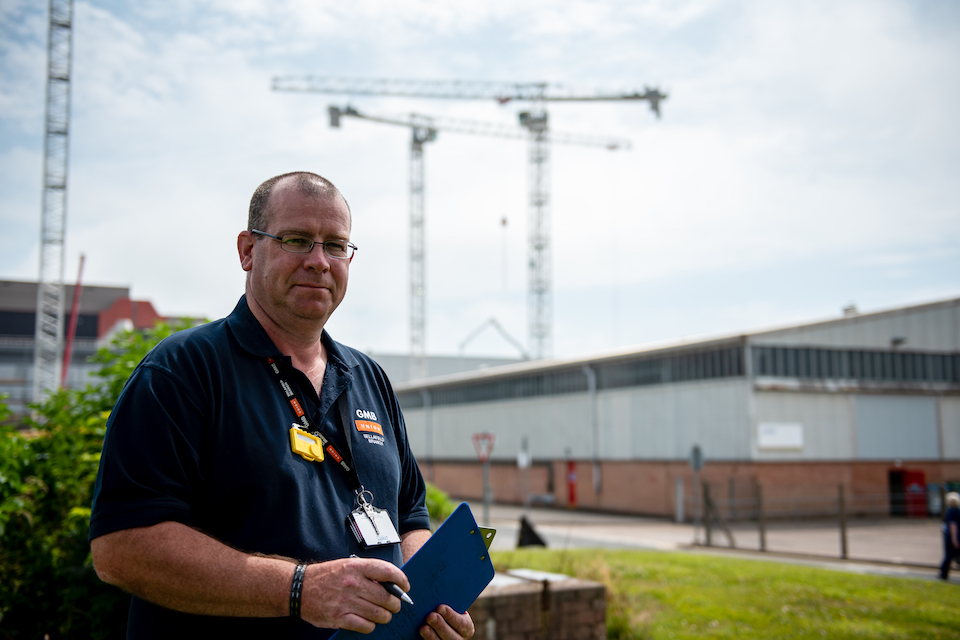
My name is Paul Holliday and I’m a full time safety representative from the GMB Union.
I’m one of 3 full-time safety reps along with my colleagues Gary Elliott from Unite and Neil Edmondson from Prospect.
We provide independent safety advice for everyone and have the same goal – to help people be safe.
Our role involves working with many people – our employees, company leaders, unions, contractors, regulators and relevant authorities – with a focus on the health, safety and welfare of all employees.
We have open and frank discussions that are accepted - right across the board.
Since we started this role, we have a good working relationship with the company, gaining respect for each other’s options.
This past year has been like no other. COVID-19 brought new challenges and work as we helped create our Enterprise Risk Assessment which set out additional controls needed to reduce the risk from COVID-19, and then getting those controls established.
I worked from home and on site, doing safety walkdowns helping with local risk assessments of COVID-19 arrangements, speaking to colleagues at work, addressing questions and helping to get resolution.
I’m proud of our people and how they dealt with the pandemic, especially during first lock down as it was something we’d never faced before. It was difficult.
To those teams who kept coming into work, keeping plant and themselves safe, I thank them all and everyone who worked from home to help keep our site and people safe.
I’m also proud of the work we do with other colleagues across the NDA group and nuclear industry to share safety learning.
This continued over the pandemic with regular video calls with safety representatives from Magnox, discussing COVID-19 controls and best practice.
COVID-19 was one risk that needed to be managed throughout 2020/21, but our other risks also remained, requiring control, mitigation and improvement actions, mitigation and improvement actions.
The following graphs show our safety performance in the areas of nuclear safety, radiological safety, environmental safety and conventional safety along with details of any incidents and events.
Performance during 2020/21 was generally good, recognising that a reduction in the number of employees within the workplace has contributed to our safety metrics.
The frequency of significant events and near misses have also reduced when compared to previous years.
In addition, safety improvement programmes continued with some examples of success being in the conventional safety improvement programmes, the nuclear safety improvement programme, environmental management, carbon reduction and overall radiological performance.
The profile and increased focus on environment and sustainability at Sellafield Ltd has been positive but much more remains to be delivered as the UK drives an ambitious programme for the environment.
Managing the risks from nuclear, radiological, conventional and fire safety continue to be an integral part of the delivery of work.
The improvement programmes have helped to drive enhanced performance, and our goal remains to be top quartile in NEHS within the sector and across all of UK industry.
8. Safety
We use these metrics and others to scrutinise our performance, identify areas for improvement and put plans in place to close gaps to achieving excellence.*
INES Events
The International Nuclear and Radiological Event Scale (INES) is a rapid alert system used for consistent communication of events across the nuclear industry.
These are categorised between Level 1, which is an anomaly, to Level 7 which represents a major accident.
See INES scale (below).
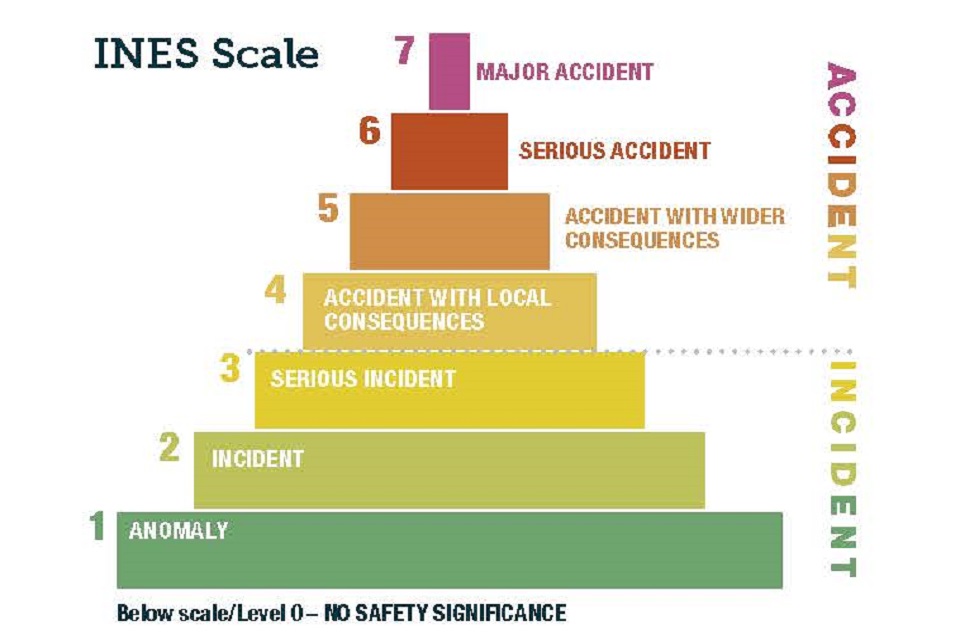
There were 4 INES events in 2019/20 and 1 in 2020/21.
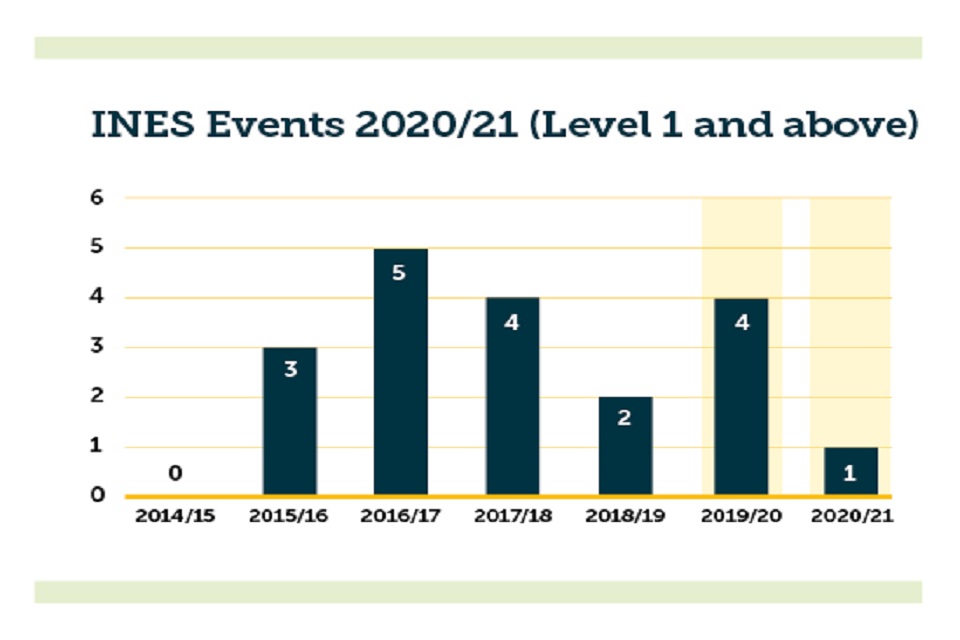
2019/20
- Implementation of operator instruction – Level 1
A review was carried out following the transfer of filters from one area of a Sellafield building to another area of the same building.
This found an operator instruction had not been fully carried out during the transfer and that correct personal protective equipment had not been worn by some operators associated with the activity.
The task was carried out without incident, and there was no impact to the people, plant or the environment.
- Operations outside scope – Level 1
A safety case produced for the continued safe storage of nuclear material in a storage facility on site was implemented outside our arrangements.
The chosen method of implementation was through a safety summary document in order to close the existing gap in safety case scope in a timely manner.
While undertaking an engineering inspection of the area to inform the development of the safety case in readiness for the next phase of operations relating to the material, the workforce were unaware of certain restrictions imposed and carried out an action – the removal of a dummy shield plug – that was outside of the scope of the safety case.
There was no safety consequence as a result of this action.
- Sump tank levels– Level 1
Sellafield Ltd has detected that the liquid levels in a concrete sump tank in the legacy ponds area of the Sellafield site had fallen.
The loss in levels was recorded following recent maintenance work on the tank.
An engineering team assessed the tank and investigated the root cause of the liquid reduction.
As a precaution the local monitoring and detection systems around the tank were enhanced.
There was no risk to the general public or the workforce. The relevant regulators have been notified. There was no health risk to the workforce or the community as a result of this leak.
- Silo liquid imbalance – Level 2
Routine liquor level monitoring on the Sellafield site has indicated there has been a recent leak from the Magnox Swarf Storage Silo, a legacy storage facility which is a priority for decommissioning.
In the 1970s there was a confirmed leak at the same plant and recent data suggests that this has reoccurred. This was always a known risk that we have prepared for. The regulators have been notified.
The building is partly sited underground, the area of the leak is also below ground and therefore there is no health risk to the workforce.
Movement of radioactive material through the ground takes many years and there is also no health risk to the local community.
At Sellafield, we have a well-developed programme to monitor the underground environment. There has been no change to conditions presently detected as a result of this leak. A well-established management plan is being followed to continue to monitor the current situation.
*all metrics correct at the time of publication
Contamination created as a result of the leak will be dealt with in line with the current ground remediation plan for the area surrounding the Magnox Swarf Storage Silo, once it is fully decommissioned.
The vital mission of removing waste from the Magnox Swarf Storage Silo remains the key hazard and risk reduction priority and this is scheduled to start in 2021/22.
This event underlines how important the job is to get the waste out and to decommission the building.
2020/21
- Leak to ground – Level 1
During a routine transfer of material between two adjacent tanks in the Thermal Denitration Plant on the Sellafield site, a quantity of uranyl nitrate liquor breached pipe work via a small perforation in the line.
The leak, that occurred within a controlled area of the site, was stopped within 20 minutes of it being discovered.
We have since replaced around 18 metres of pipework and renewed the lagging and trace heating along approximately 120 metres of the pipeline. There was no risk to our workforce or the community. We have engaged with our regulators.
Sellafield Incident Reports
Nuclear SIRs
This metric represents the number of Radiological Site Incident Reports (SIRs) radiological events categorised as significant under our sentencing scheme.
There were 3 recorded during 2019/20 and 1 recorded in 2020/21.
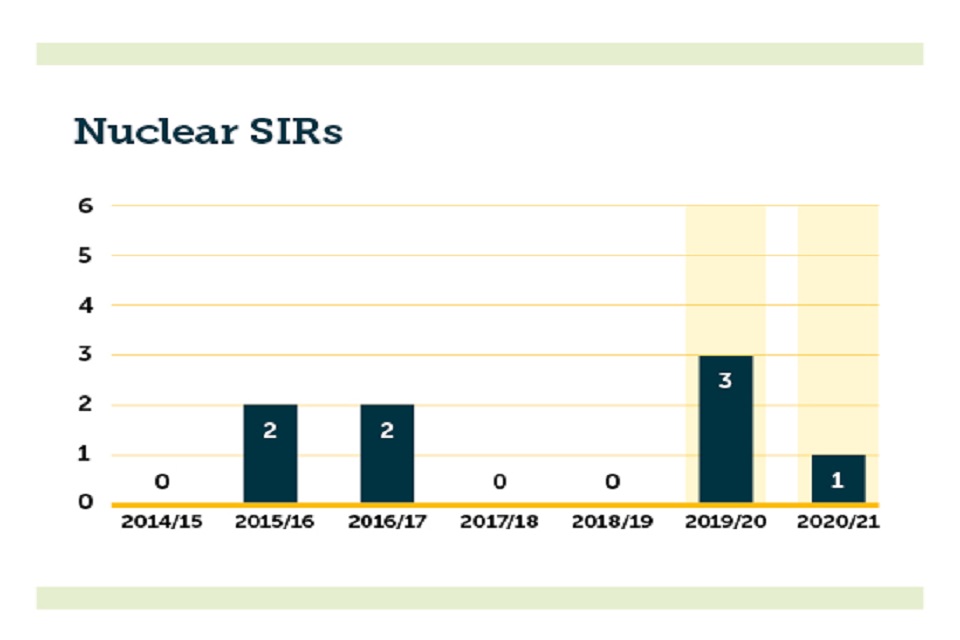
2019/20
Silo liquid imbalance - See INES events for further details.
Operations outside scope - See INES events for further details.
Implementation of operator instruction - See INES events for further details.
2020/21
Leak to ground – Level 1 - See INES events for further details
Radiological SIRs
This metric represents the number of Radiological Site Incident Reports (SIRs) radiological events categorised as significant under our sentencing scheme.
There were 4 recorded during 2019/20 and 1 recorded in 2020/211.
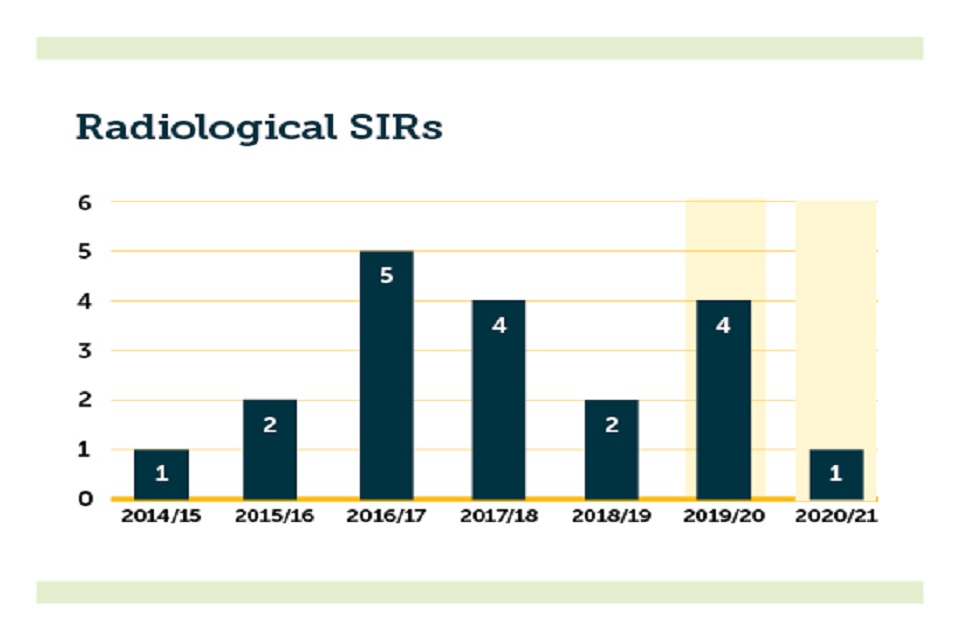
2019/20
Contamination to person and plant
A person was treated for contamination to the hand after removing a weed from a duct adjacent to a walkway within a radiation-controlled area on the Sellafield site.
A skin dose assessment confirmed that no significant radiation dose was received by the individual. The surface around the location has been confirmed to be clean at natural background levels.
Trapped hand
An operator caught fingers of their hand during removal of a tank during decommissioning operations. The work was being undertaken in a controlled area and the individual was wearing an air fed suit. During undressing, cuts were discovered on the individual’s fingers.
There are no indications that the gloves have been holed, all appear to have remained intact. The operator followed the correct egress procedure and attended occupational health for additional assessment and the local hospital where no hand fractures were identified.
No medical treatment was required. This is a radiological SIR based on potential.
Sump tank levels - See INES events for further details.
Silo liquid imbalance - See INES events for further details.
2020/21
Leak to ground - See INES events for further details.
Recordable personal (skin) contamination events
This metric provides the number of personal (skin) contamination events and was adjusted to take account of all skin contamination events and not just the ones recorded at surgery.
We continue to work with workforce radiological protection working groups to prevent further contamination events.
The radiological improvement governance group is taking learning and best practice from across Sellafield, to share and deliver improved performance.
During 2019/20 and 2020/21 all doses to employees remained as low as reasonably practicable and none of the personal contamination events resulted in internal dose to employees.

Environmental SIRs
This metric represents the number of environmental Site Incident Report (SIR) events categorised as significant under our sentencing scheme and includes non-compliances of the environmental permit.
We promote a culture where environmental issues are reported openly across our business so that learning can be shared.
Raising SIRs aligns closely with notifications made to the Environment Agency and includes events where there is actual or potential for non-compliance with our environmental permits.
We’ve seen a decrease in the number of environmental SIRs over 2019/20 and 2020/21.
None of the events in either financial year resulted in significant damage to the environment.
Examples of environmental SIRs include: misrouting of waste; water treatment chlorine discharge greater than permit limit, and Uranyl Nitrate leak from pipe to ground.
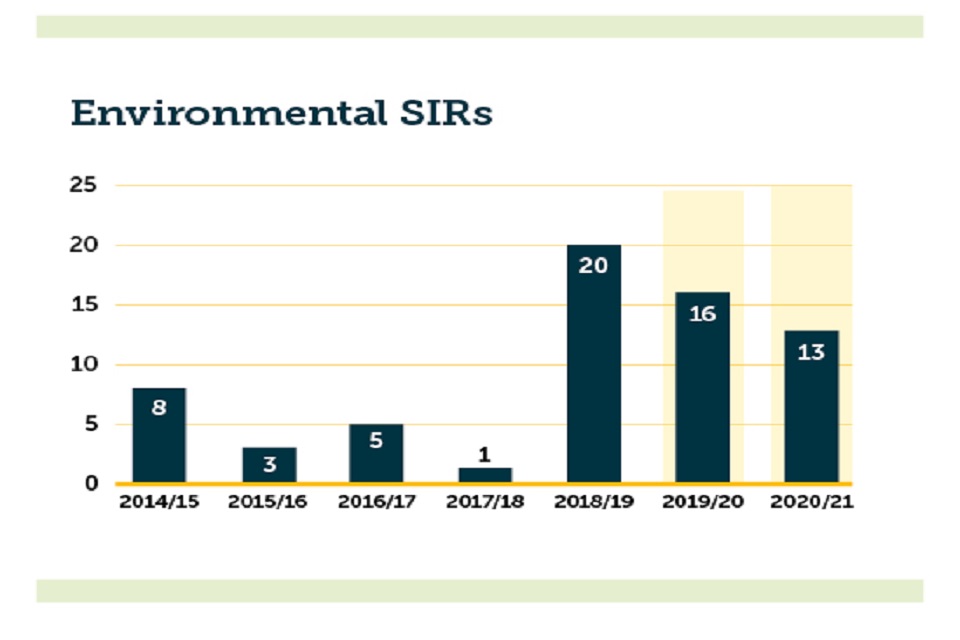
Lost Time Accident Rate
This metric records the 12 month rolling average rate of lost time accidents (accidents resulting in more than 1 day from work) per 200,00 hours worked.
Our Lost Time Accident rate has reduced in 2019/20 and again in 2020/21 and currently stands at 0.13. We remain focused on reducing the number of Lost Time Accidents.
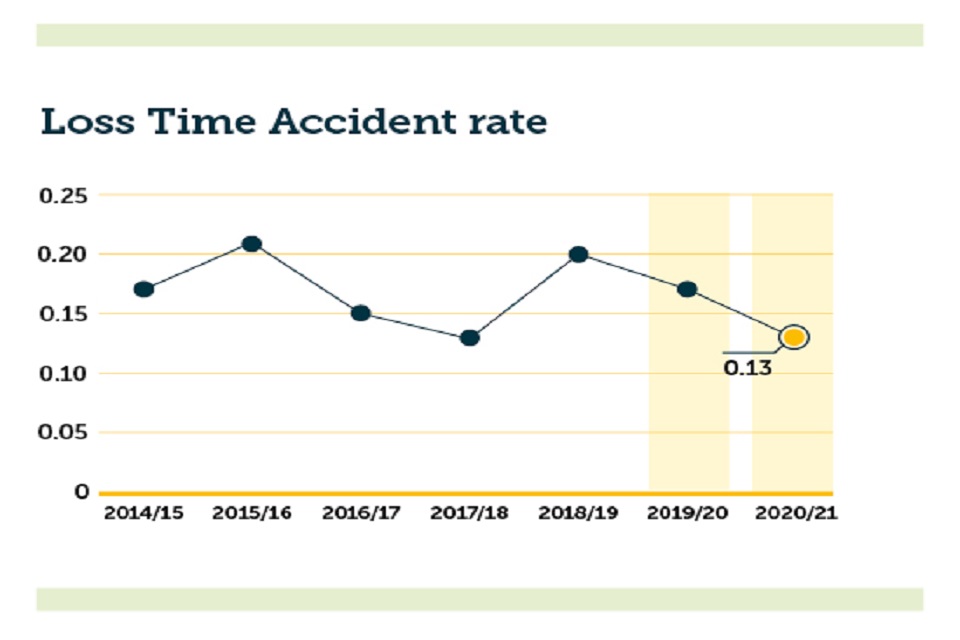
Total Recordable Incident rate
This records the 12 month rolling average rate of all total recordable incidents (accidents resulting in lost time or medical treatment) per 200,000 hours worked.
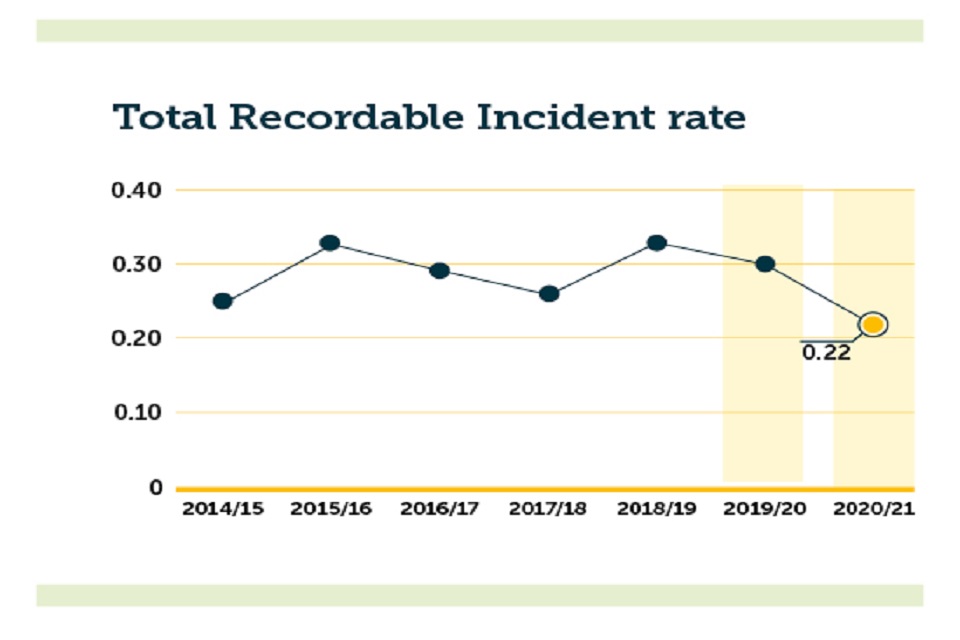
RIDDOR Injury rate
This metric records the rate of RIDDOR (Reporting of Injuries, Diseases and Dangerous Occurrences Regulations) injuries which result in employees being away from work for more than 7 days, and specified injuries such as broken bones.
The figure shot is the 12 month rolling average rate of RIDDOR events per 100,000 hours worked.
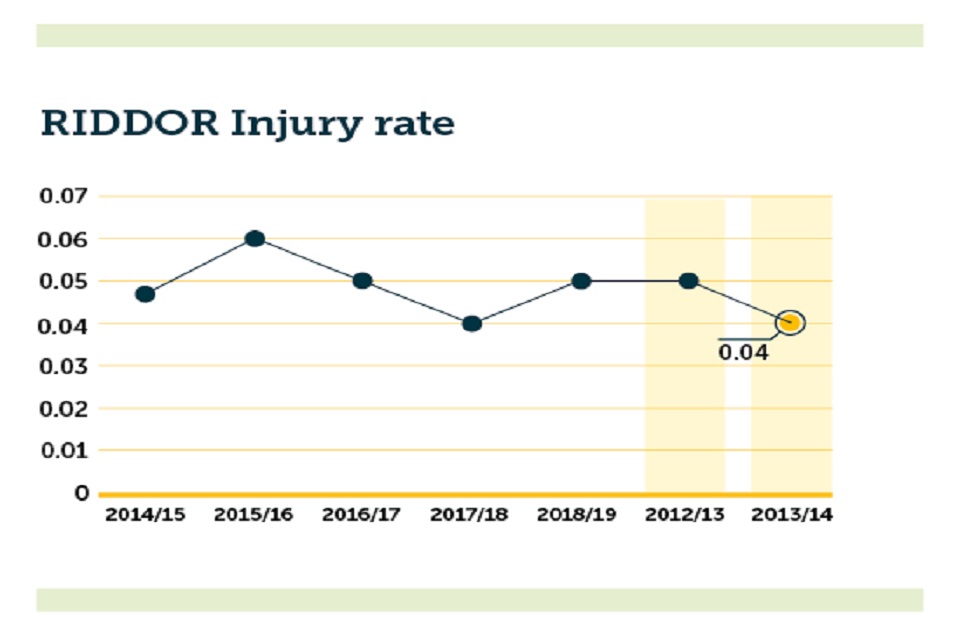
Dangerous Occurrences
This metric records the number of RIDDOR (Reporting of Injuries, Diseases and Dangerous Occurrences Regulations) dangerous occurrences. These include power dips, failure of lifting equipment resulting in a broken arm, a grab becoming detached from a hoist cable, and injuries sustained during electrical operations.
All these events are investigated to learn lessons and implement actions to prevent reoccurrences.
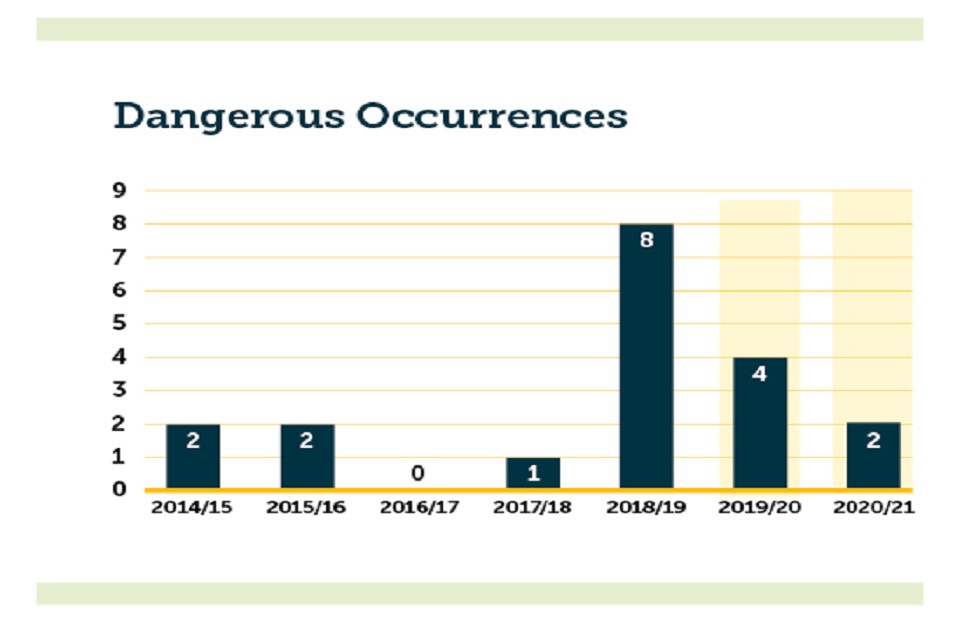
A sustainable approach to construction
Case study - Kyle Challinor
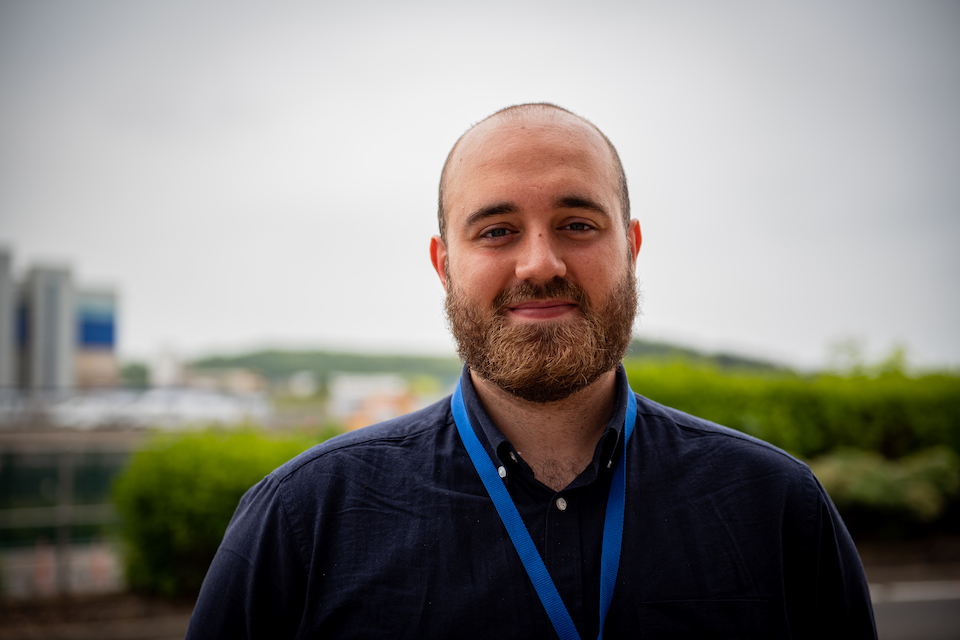
Sellafield is home to one of the largest portfolios of complex major projects in the country, creating the facilities we need for the next stage of our purpose. That means we use a lot of concrete.
To find out how sustainable we are in our use of concrete – and to see if we could improve – a team from Sellafield Ltd and our colleagues in our project and programme partners came together to investigate. That team included graduate Kyle Challinor.
My name is Kyle Challinor and I am a civil engineering graduate and joined the Sellafield Ltd graduate scheme in November 2020.
Concrete is an immensely useful and versatile material, especially when paired with reinforcing steel, and is primarily required at Sellafield for structural and shielding purposes.
My proudest moment this year has been finding that we’ve been using sustainable concrete at Sellafield since the early 1980’s and that Sellafield Ltd is still keen to investigate all opportunities to improve further and be an industry leader in concrete sustainability.
Concrete’s fundamental constituents are cement, aggregates and water. Cement production is a carbon intensive process (cement production contributed to 5% of annual anthropogenic global CO2 production in 2008).
The concrete used at Sellafield since the early 1980’s has used either a high percentage (50%-70%) of GGBS, a waste material from steel production, or (30%- 40%) PFA, a waste material from coal fired power stations which is used to partially replace cement in concrete mixes.
Potentially confusing acronyms aside, this means that the concrete used at Sellafield is more sustainable because we use less cement and make use of waste products from other industries.
And we’re not stopping there. We’re also looking into creating a circular economy for recycled concrete across the NDA group, delivering bulk concrete aggregates by rail to remove thousands of trucks off the local road network and utilising novel industry innovations in concrete technologies.
A sustainable approach to construction.
Being environmentally conscious
My name is Kara Roberts and I’m a business change manager in the utilities and electricity generation part of the organisation.
Providing Sellafield with the power it needs in the form of steam and electricity means that the infrastructure teams are responsible for the vast majority of the site’s carbon footprint in what we call scope 1 and 2 emissions. Scope 3 includes carbon produced through construction.
My role this year has been to establish an environmental capability and an accurate baseline of our current contribution to the site’s carbon footprint. The capability will then deliver measurable decarbonisation activities – such as leak management projects and creating an integrated energy strategy – to bring that number down.
We won’t do it alone – the team is working with experts across the organisation, from the supply chain and with experts in the field of sustainable service provision.
In doing so, we’ll support the company’s contribution to the national ambition of achieving Carbon Net Zero by 2050.
Reducing our carbon footprint will demand both short and long-term transformation - culturally, behaviourally and operationally - to enable a more sustainable, efficient and decarbonised approach to our operations.
And we need to do it whilst simultaneously maintaining business as usual operations.
I am proud to be part of a transformation programme of local, regional and national importance which will provide an enduring legacy of a significantly reduced carbon footprint.
Lighting up Sellafield…sustainably
Case study - Richard Thompson
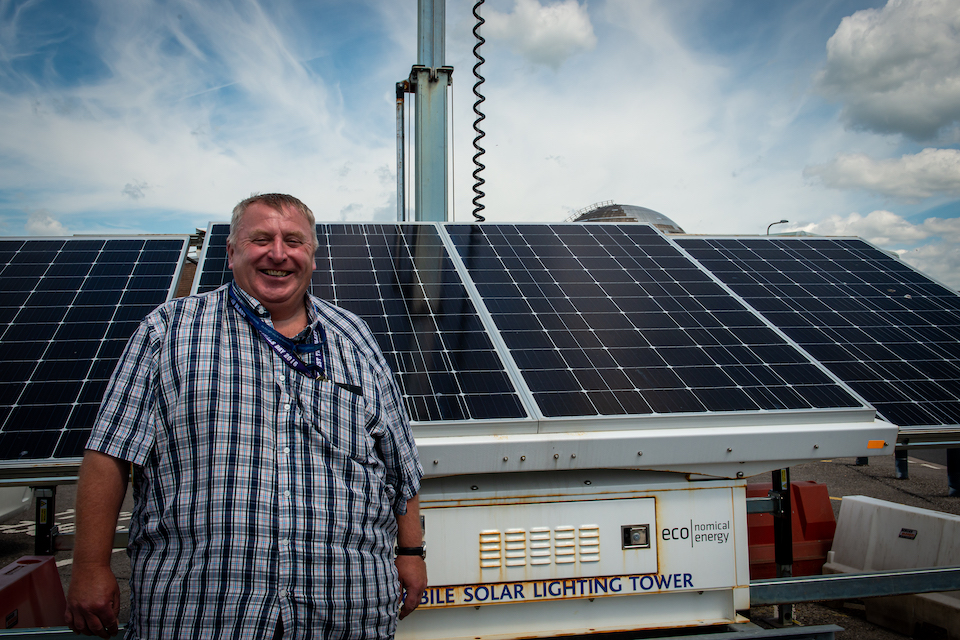
We often refer to Sellafield as being like a small town. We have our own laundry, rail network and canteens. And, because a lot of work is done 24 hours a day, seven days a week, we also have a lot of streetlights.
Traditional lights contribute to our carbon footprint, so our team pushed for a more sustainable option.
My name is Richard Thompson and I’m a street lighting equipment engineer. I’ve been at Sellafield for almost 39 years, starting out as an apprentice electrician back in 1982.
This year we installed a pilot set of 3 different types of solar LED heads on some of our streetlights on the site and monitored their performance. We ran the pilot from September through to March so that we could test how the LEDs performed when they had the least amount of daylight.
We then started a programme to replace existing sodium heads and the LED head that performed the best in the trial, as part of our routine maintenance routine. We’ve replaced more than 700 so far.
We work closely with the energy improvements team, giving them data on how the lights are performing.
They’ve also been instrumental in introducing solar powered tower lighting and temporary lighting columns that can be used across the site instead of diesel-powered equivalents.
It’s extremely satisfying to learn that our efforts are starting to make a difference and being recognised by an increasing number of specialist personnel who are fully on board with what we are trying to achieve.
It is very much an ongoing process and one that eventually see the whole site be illuminated by LED lanterns with all the savings in energy consumption and CO2 emissions that this will achieve.
9. Progress at pace
The safe, secure and sustainable operation of the Sellafield site remained our priority in what was an exceptional and unprecedented year.
Despite the impact of the COVID-19 pandemic on our operations, we continued to make progress towards our purpose of creating a clean and safe environment for future generations.
That progress included:
- removing half of the solid waste from the Pile Fuel Storage Pond, putting the programme on track to remove almost all radioactive material by 2024.
- installing the second Silo Emptying Plant machine in the Magnox Swarf Storage Silo and moving the first Silo Emptying Plant machine into position to start retrievals.
- opening a new intermediate level waste export route from our Pile Fuel Storage Pond to the Waste Encapsulation Plant.
- demolishing the First Generation Reprocessing Plant stack from 61 metre to its final height of 30 cm, removing a significant risk from the Sellafield site.
- emptying a Redundant Settling Tank and repairing a leak.
- continuing the demolition of the Windscale Pile Chimney, including the removal of some heavily contaminated blocks.
- demonstrating the route that will be used to transfer boxes of nuclear waste retrieved from the Magnox Swarf Storage Silo into the Box Encapsulation Plant and Product Store/Direct Import Facility.
That progress was made possible thanks to the efforts of our employees and supply chain partners.
We thank everyone involved in delivering our work, from those who have worked on the site throughout the pandemic to those who have embraced a new way of working, and the teams who have kept us all digitally connected.
Over the following pages those teams will share their successes and proudest moments from 2020/21.
Plugging a leak has put Sellafield on the path to a safer future
Case study - Nick Elliott
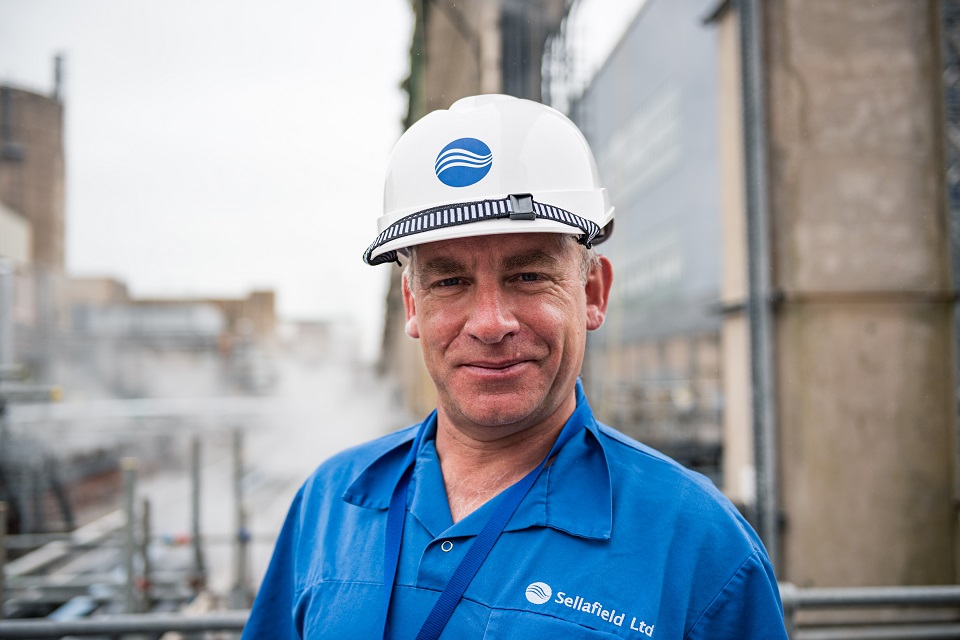
A relic from the 1950s. the Redundant Settling Tank at Sellafield sits next to the First Generation Magnox Storage Pond. It was used to store radioactive sludge taken from the outdoor pond.
In October 2019 surveillance work found the level of liquor in the sump tank was reducing at a rate of approximately 80- 100 litres per hour.
As there were no signs of a leak in the pipes connecting to other plants, it had to be assumed that the liquor was being lost to ground under or around the tank.
Although the issue posed no immediate risk to people, it required urgent work to fix.
My name is Nick Elliott and I’m currently acting as project engineering manager for the Redundant Settling Tank project. I’m also the retrievals process engineering lead.
I’ve worked on the First Generation Magnox Storage Pond retrievals project for around 12 years.
We needed to remove 15 cubic metres of sludge and 15 cubic metres of solid waste from the settling tank. The operations needed be performed at a safe distance for humans while minimising any airborne contamination, and then had to be done with social distancing when the pandemic hit.
We built a temporary works structure with a covered roof and hung a electrically operated overhead crane from the structure.
We also built a temporary control room with control and vision systems to allow all operations to be carried out remotely.
A tool kit (grabs, croppers and pumping systems) was provided to remove sludge and solid waste.
Removing the waste and sealing the sump was a significant achievement in a short space of time. I’m proud of what we achieved.
50% of solid waste removed from legacy pond
Case study - Phoebe Skillen

This year we hit the milestone of removing half of the solid waste from one of our highest hazard facilities, the Pile Fuel Storage Pond.
My name is Phoebe Skillen and I’m a plant solid waste coordinator and building manager. I’ve worked at Sellafield for 5 and a half years and joined the Pile Fuel Storage Pond team 4 years ago.
Our task was to remove equipment from the pond that used to be used for underwater fuel reprocessing operations, with a target of removing 12 skips. That equipment is now surrounded by radioactive sludge and each item has to be assessed to determine the most cost-effective disposal route.
Doing the work during the pandemic brought extra challenges, but so did winter as we couldn’t retrieve when it was too cold, wet or windy. But at the end of the day we did it, beating our stretch target of 12 skips by retrieving 14 skips.
I was really happy to be part of the team that exceeded the expectations of the business.
Machine moves towards risk reduction
Case study - Katherine Hambling

I’m Katherine Hambling. I’m a sub project manager and have been at Sellafield for 13 years.
I’m part of the team installing retrieval machines into the Magnox Swarf Storage Silos, a key part of our bigger task of emptying the legacy facility.
Once installed, 3 retrieval machines will move from compartment to compartment in the silo, lifting out waste so that it can be treated and stored. Once empty we can then demolish the silo structure.
This year we were able to move one of these machines inside the silo, and that was a real personal highlight for me – a truly fantastic achievement for a project that’s been ongoing for more than 2 decades.
Changing roles leads to retrievals success
Case study - Kyle Nicholson
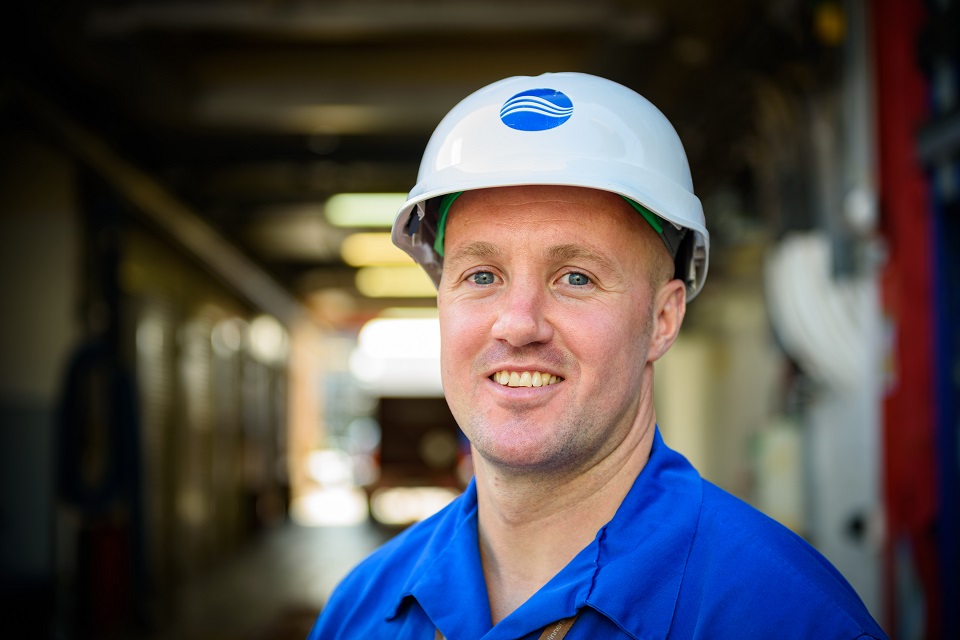
My name is Kyle Nicholson and I’m an operations team leader in the First Generation Magnox Storage Pond. I’ve been at Sellafield Ltd for 8 years.
I was part of the five-person crew that monitored the safety of the pond 24/7 when we went into the first national lockdown.
Later in the year I switched into a retrieval’s operations role in the plant so that we could catch up on hazard and risk reduction work.
We reached and exceeded our operating targets against all the odds. We worked as a team and we’re all so proud of what we achieved.
Here in legacy ponds we’re used to coming up against unique challenges all the time – it’s part of the job when you’re doing so many things for the first ever time. We’ve never experienced a challenge like COVID-19 before though.
The fact we proved we could deliver through that has brought us closer together.
Changing the Sellafield skyline
Case study - James Temple

How do you decommission a 125-metre ventilation chimney that was damaged and radiated during the Windscale fire in 1957?
One block at a time.
Our teams and supply chain partners cut the diffuser at the top of the structure into large blocks before lowering them to the ground using a tower crane that was bolted to the side of the chimney.
Some blocks were easier than others thanks to varying levels of surface contamination that had to be removed, and then the team had to adapt to COVID-19.
I’m James Temple the sub-project manager at Windscale. I started on site back in September 2014.
At the start of the pandemic I worked from home before coming back onto site in May 2020 as part of a team put together to restart our project.
We worked hard to apply the COVID-19 requirements to a nuclear decommissioning project so that people could work safely.
Some parts were particularly challenging, for example social distancing when there isn’t much room at the top of the chimney and the Alimak lift used to get to the top is small, but we got there.
It brings great work satisfaction knowing that the Pile 1 Chimney demolition team is making a visible change to the Sellafield skyline.
I’m particularly proud of being part of the team that helped to restart the project during the pandemic. It was all new to everyone and it was a real challenge.
10. Making progress…sustainably
Later in this report we set out our sustainability principles that were launched in 2020/21.
A key attribute of our approach to sustainability is that it is runs across all of our work, increasingly embedded in the business rather than the responsibility of a few.
It is through our employees understanding of their tasks and their ability to identify a more sustainable approach that we will make the biggest collective impact.
That’s exactly what the team behind the decommissioning of the Windscale chimney have done.
The chimney is being dismantled block by clock. Their original plan for those blocks was to place them in half-height ISO freight containers, fill the containers with foam grout and then transport them 126 miles to a landfill near Preston.
They knew there was a better way. So instead they built a waste handling facility next to the Chimney where they put the blocks into purpose made PacTec bags and disposed them at the Calder Landfill Extension Segregation Area on site.
Thanks to them we are:
- using 2,733m³ less landfill space
- burying 2,733m³ less waste (that’s equivalent to 10 double decker buses)
- using 375 fewer journeys
- driving 53,317 fewer miles
- reducing CO² emissions by 70.5 tonnes
The CO² saving is equivalent to:
- driving 15 passenger vehicles for one year
- the annual energy use of 8.4 homes
- charging 8.9 million smartphones
Taking a One NDA approach to achieve drone success for all
Case study - Peter Allport

I’m Peter Allport and I’m remote handling and low voltage equipment programmes lead. I’ve been at Sellafield for 7 years and I’ve been part of the team tasked with gaining the approvals and permissions needed to fly unmanned aerial vehicles at Sellafield.
No mean feat for a site that is home to some of the highest nuclear risks in the country and that is covered by a no-fly zone.
We’ve managed to get permissions to use the unmanned aircraft (normally referred to as drones) at Sellafield for a while, and this year I’ve been part of a group looking into the possibility of having one NDA application for the vehicles.
It has been great to witness first hand the enthusiasm for this combined approach from people across the NDA group, supply chain and regulators.
What started as a ‘wouldn’t it be great if’ conversation has turned into a piece of work with real potential.
A personal highlight has been seeing the doors open to other nuclear sites within the NDA group and working in a more collaborative way under this One NDA umbrella. It allows us to maximise value for the taxpayer and that really motivates me, especially given the year we have all had as tax paying citizens.
Keeping the lights on
Case study - Glynn Davies
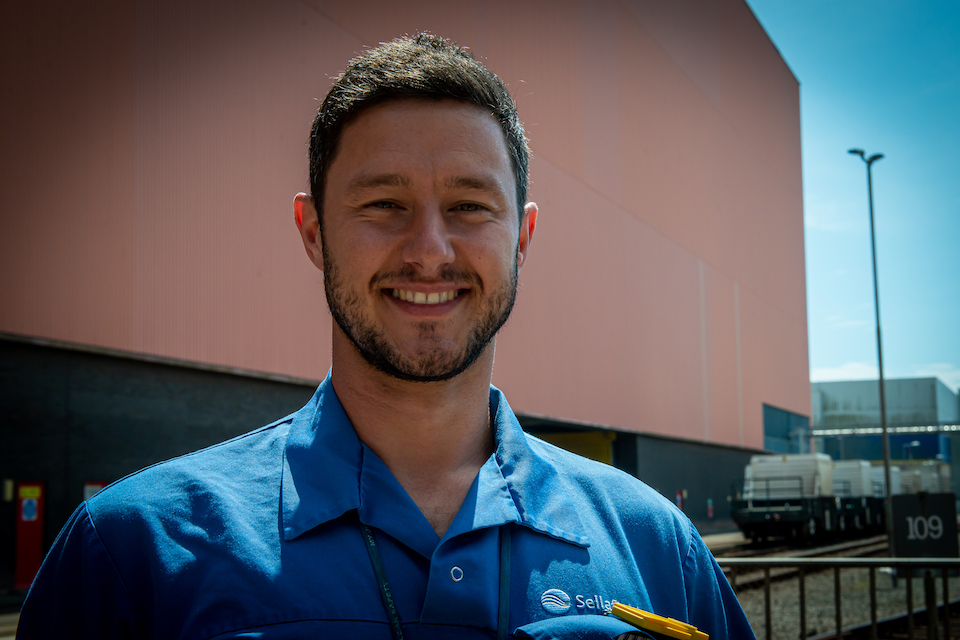
We’ve nearly completed our reprocessing mission at Sellafield, but our knowledge, skills and assets around how to safely manage used nuclear fuel has continued to help keep the lights on across the UK.
Throughout the pandemic many of our teams continued to attend Sellafield to keep the site safe and secure and to operate the nuclear facilities that form part of the country’s energy infrastructure.
That includes the team in the Fuel Handling Plant who were there throughout to receive used nuclear fuel from EDF Energy nuclear reactors.
I’m Glynn Davies and I’m a health physics team leader support. I’ve got 9 years of service at Sellafield.
Myself and my team, as well as our counterparts on the other 4 shifts, attended throughout the pandemic ensuring the continuous operations of the Fuel Handling Plant and Site Ion Exchange Plant.
We maintained our service provision to the facilities enabling the operations teams to carry out their duties to meet the requirements of EDF and ‘keep the lights on’ around Britain.
We did this as well as contributing to the health physics emergency response numbers required for the site to continue operating.
I am proud of the fact that I was involved in playing a part in the recovery of the pandemic in Britain. I was one very small cog among others in a large machine ensuring hospitals were supplied with the power they needed to provide lifesaving treatment to individuals who had unfortunately contracted COVID-19.
Doing the job that was too hard to do
Case study - Graeme O’Pray

Sometimes maintaining the thousands of engineered parts that make up our nuclear facilities presents a challenge that is (almost) too hard to do.
That was the case in our waste treatment complex when we needed to do an oil change, inside a compactor that we use to reduce the size of low level waste drums, which in turn was inside a glovebox in a high radiation area.
I’m Graeme O’Pray. I’m a maintenance team leader and have been at Sellafield for 19 years.
I was the team leader on the job, giving daily briefings, objective setting, compliance checking, control and supervision, and doing welfare and individual checks on team members.
We formed a COVID-19 bubble at the start of the task and continued this throughout. The task was completed with no injuries, no contamination events and no COVID-19 cases.
I’m really proud of the teams spirit and their positive attitude, in what were unprecedented times, this enabled the oil change to be completed.
The way the maintenance team outside of the oil change were able to work around the oil change task resulted in the delivery of the return to service maintenance which needed to be completed prior to plant returning to operations.
Keeping colleagues safe
Case study - Barry Ferguson

Our facilities management teams were played a key role in helping to keep Sellafield safe and secure throughout the COVID-19 pandemic.
They supported our nuclear facilities and our site and off-site offices, keeping them clean and helping the teams to create and maintain COVID-19 secure working arrangements.
I’m Barry Ferguson and I’ve worked for Mitie for over 14 years. I started as a cleaner and I’ve been a cleaning stores supervisor for 3 years.
My role over the last year has been very demanding, making sure that we have what we need in our cleaning stores to fulfil the site’s demands during COVID-19.
I worked closely with current and new suppliers to make sure we had the correct cleaning products so that the site could reopen. I helped to make and deliver anti-bac stations of bio-wipes and hand sanitiser around the site as well as doing my normal duties.
I’m proud of myself and my team for stepping up due to the work demands and of the way we worked in an environment that was changing day by day. I’m proud most of all knowing that the work I did in some small part helped people return to site.
Boxing clever
Case study - Akber Latif

Retrieval of wastes from Sellafield’s legacy ponds and silos is nationally important work.
Moving the waste into modern storage will mean a huge reduction in the UK’s nuclear hazard, but before we can remove the waste, we have to be confident we have somewhere safe to put it and that we have a reliable supply of containers for decades to come.
I’m Akber Latif. I joined Sellafield in 2014 and I’m the sub project manager for 3m3 box manufacture for the Pile Fuel Cladding Silo and the Magnox Swarf Storage Silos.
The containers we need have been designed to keep the waste we put inside them safe forever. So, as you can imagine, everything must be very precise, from welding and grouting through to how they are inspected during the manufacture process.
I worked with the manufacturing team at Stainless Metalcraft, supporting the development a procurement of their production line, equipment and tooling so that they could achieve the 2 box per week throughput we need for the silos at Sellafield.
A key part of my role was capturing and sharing learning between Sellafield, Stainless Metalcraft and Darchem Engineering who were also producing boxes for us.
Seeing people collaborate rather than compete is fantastic, and ultimately means we can exploit all opportunities to reduce costs and improve schedule and quality.
This year we finished the first phase of the Pile Fuel Cladding Silo box manufacture, giving everyone confidence that we have the box manufacture capability, throughput assurance and that we can meet the required quality expectations for future stages.
Doing what we said we would
Case study - Jonathan Clingan

Part of our commitment when we reprocessed used nuclear fuel for overseas customers was that the high level waste created by the process would be returned to them, rather than staying in the UK.
I’m Jonathan Clingan and I’m the highly active liquor programme manager. I joined Sellafield Ltd (or BNFL as it was then) as an apprentice in 1986.
I’ve been involved in the high-level waste programme since the 1990s, working on our Residue Export Facility from its construction through to full operations.
Returning waste is a real NDA group wide effort, involving teams at Sellafield, the NDA corporate centre and Nuclear Transport Solutions.
We all have the same objective – get the waste home safely and effectively.
It was a real challenge when the COVID-19 pandemic hit the programme, resulting in the German shipment being delayed.
I feel immensely proud of the teamwork and commitment of all involved in achieving the first return to Germany, in what was a difficult time for all in the UK and Germany and given the complex working arrangements due to the pandemic.
Finding new ways to reach out
Case study - Sarah Corlett

My name is Sarah Corlett. I’m a communications officer and have worked for Sellafield for the last 18 years.
The speed of the virus and subsequent lock-down meant that in a matter of days our workforce went from one which had become used to going into work and engaging in our corporate communications and receiving information in a certain way, to a working community that was scattered to the four winds with initially no IT solution in sight.
The corporate affairs team had to create a new normal in helping the business reach out remotely to people using new channels, new communications tools and pioneer a change in our communications approach.
This was the time when our employees needed information more than ever.
We had for a couple of years increasing our reach to employees on platforms a staff information area on our GOV external website and other social media channels like Twitter, LinkedIn, Instagram and WhatsApp.
The pandemic made us look even more closely at these channels and revolutionised how we used them.
I’m very proud of the way we worked as one team and delighted that this was showcased in the Wave Awards with the whole team picking up the ‘cultural innovation’ category award for ‘reaching out remotely’.
This was very much a team effort from start to finish and even now we’re far from finished adapting to even more new ways of working within the business.
What we achieved as a team during those initial few months in the first lockdown can never be undervalued.
Building during a pandemic
Case study - Joe Ashbridge

Building at Sellafield is not without its challenges. This year brought the added complication of COVID-19. But our teams and supply chain rose to the challenge, making major projects some of the first activities to restart on the site following the first lockdown in March 2021.
My name is Joe Ashbridge and I’m a civils supervisor. I’ve worked on the Sellafield site for 15 years as part of the supply chain.
Right now, I’m working as part of the team on the Sellafield Product and Residue Store Repackaging Plant.
My proudest moment of the last financial year was seeing the way that such a large number of people all worked together to ensure that everyone had the confidence to return to work safely.
We started with getting a small team together so that we could carry out the necessary changes to the project offices, canteen, change rooms, toilets, etc. and to make access to the construction site COVID-19 secure.
Before a single sticker or poster was put up and before one-way routes were established we shared our plans with people from the project management team, the workforce, trade unions and safety colleagues so that everyone understood what we were trying to achieve, and how.
The next stage was organising the delivery of materials, plant and people to site in order to execute the changes required.
It was logistically challenging however everyone both directly and indirectly involved pulled together to make it happen.
An industry first during COVID-19
Case study - Danielle Hannah
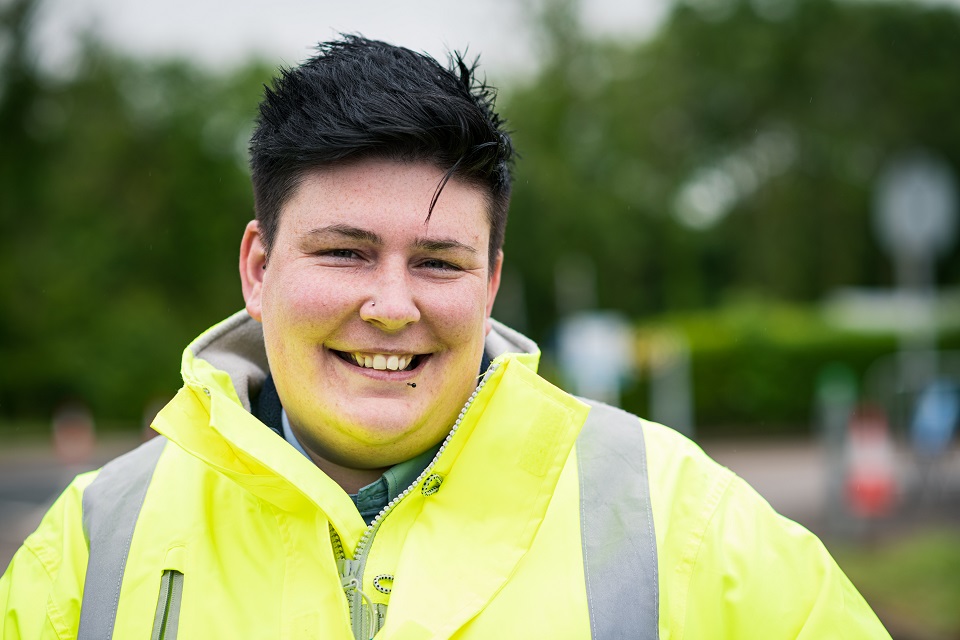
With the support of our owner, the NDA, and our public health partners we were able to quickly set up the first industry based COVID-19 test and trace facility in May 2020.
The centre was initially for Sellafield Ltd employees and the supply chain but was later expanded to include household members.
The facility has allowed us to track the spread of the virus on the Sellafield site in real time, helping us to maintain safety and security throughout the pandemic.
My name is Danielle Hannah. I’ve been part of the OneFM security team at Sellafield for the last 3 years and part of the test station team for the last 11 months.
We came together as a team to provide a high-class testing facility. The test facility has enabled projects to proceed on site and allow staff still to come to work.
We’ve completed approximately 6,290 tests but what I’m most proud of is how we’ve worked as a team – nothing was every too much for us and I feel like I’ve found a workplace where I feel I belong.
11. Lifetime Value for Money
Our ambition of a workplace where everyone feels included, respected and able to work at their best is something that we’ve been working hard on, at every level of or organisation.
There is more to do, but we’re proud of the progress made so far.
That progress included:
We have twelve employee support networks, with more than 850 members, helping to raise awareness, share knowledge, challenge and support colleagues in a range of diversity and inclusion topics.
They are:
- BAME Network
- Chronic Illness Peer Support Network
- Domestic Abuse Contacts
- Dyslexia Network/Assistive Technology
- Enduring Mental Health Conditions
- Family Network
- OneLGBT+ Network
- Mental Health Champions Network
- Nuclear Autism Support Network
- Nuclear Stammering Network
- Sellafield Menopause Support and Action Group
-
Stronger Together Cancer Support Group.
-
We also launched a Long Covid group to support employees who are suffering as a result of coronavirus.
-
Our D&I Information Hub has been visited more than 50,000 times since its launch in 2018, by colleagues looking to learn more about how to get or give support and guidance.
-
We have more than 180 fully trained mental health champions in our business, providing support and signposting to colleagues in need, and raising awareness of mental health and wellbeing issues in the workplace.
-
We have trained and deployed nearly 50 domestic abuse contacts in our workforce, to give proactive advice, signposting and support in the safety of the workplace. We’ve also supported charities and groups that help those who have suffered as a result of domestic abuse.
-
Working closely with MIND, the national mental health charity, we have delivered more than 100 mental health awareness sessions to more than 1,000 employees throughout the pandemic. We’ll continue to run these, along with more bespoke learning opportunities, throughout 2021.
- We took the lead on three D&I ‘beacon projects’ for the NDA in 2020 - fairness and meritocracy, agile working, and inclusive leadership. We’re now busy implementing the outcomes of these vital projects.
Our executive team has just approved a new 7-year strategic approach to D&I at Sellafield. Its focus is simple: ‘Respected. Included. Performing at our best.’ This builds on our previous D&I strategies over the past 5 years.
A major focus of that strategy is to embed inclusion and inclusive behaviours in all our people-related activities, supporting and aligned to our manifesto and enterprise strategy commitments.
We are focusing particularly on four improvement plans in 2021, all being delivered and led by passionate colleagues across the business:
- mental health
- race
- gender balance
- LGBT+
We are also rolling out D&I training for all employees during 2021 and putting inclusion at the heart of our leadership development activities, and employee induction and onboarding.
Reverse mentoring
Case study - Joseph Ghayouba
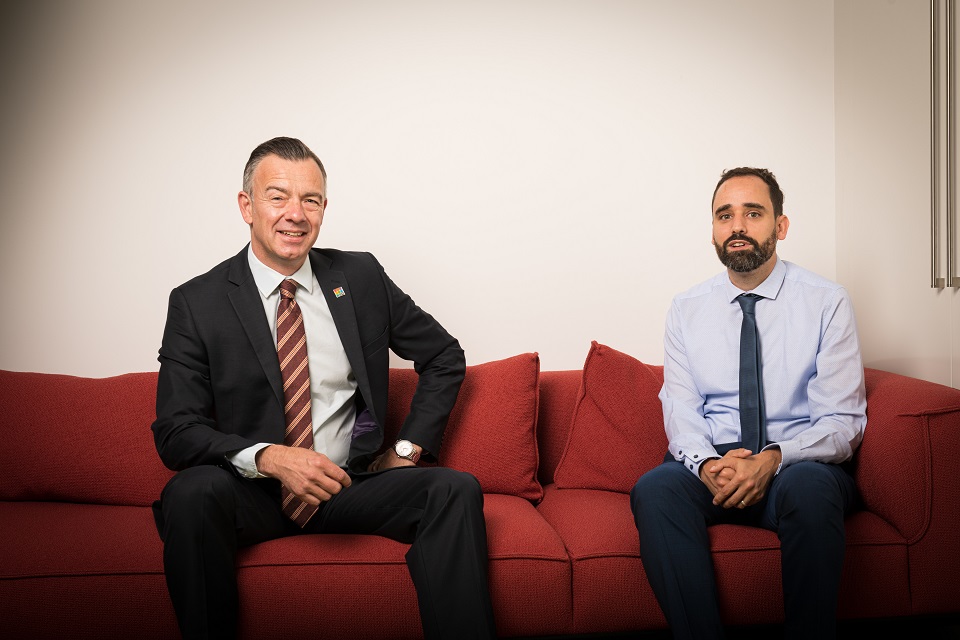
Martin Chown (left) and Joseph Ghayouba (right)
Mentoring within organisations is traditionally used to transfer skills and knowledge from senior employee to more junior roles.
Reverse mentoring is different. It’s benefit still lies in the transfer of experiences and knowledge, but the focus is on an equal exchange of views and is independent of grade, rank or position.
This year our BAME network introduced reverse mentoring, working directly with our executive team.
I’m Joseph Ghayouba and I’ve worked on the Sellafield site since 2013.
I started off as an operator and then moved up to assistant team leader and operations support working as a waste co-ordinator. I’ve just started my new role as a waste advisor.
My proudest moment is that I also heled found the BAME network, creating a space for BAME employees. One of the first things we did as a network was to put together a strategy document with a list of recommendations to the company to improve racial equality.
The company signed up to a national charter and appointed a senior sponsor, Michael Ditchburn. He has been invaluable with his insights and experience at Sellafield.
The company has also put together a steering group with stakeholders from across the business and members of our network to deliver an improvement plan, looking at issues such as progression, recruitment, retention and data.
As well as the company driving improvements, we wanted to make a difference as a network. One of our ideas was that of reverse mentoring where we paired up with members of the Sellafield Ltd executive team.
Mentoring is traditionally centred around the development of junior employees by those in more senior positions and so can be a one-way process. Through reverse mentoring we wanted to work with members of the executive so that they and we could bring our different experiences and perspectives and learn from each other.
My reverse mentoring partner is the CEO Martin Chown It has been going well, I have been sharing articles suggested books and podcasts to read and it has been a good honest and open dialogue which is vital for any reverse mentoring process to succeed; there has been a lot of news about racial equality so there is always something to discuss.
It was recently Ramadan so he was keen to understand what it is like to work whilst fasting. We have talked about the manifesto and ideas for how the BAME network can support that further and what can be done to really transform the culture at Sellafield.
It has also been a good experience for me because I get an insight into the type challenges that Martin and his lead team take on whether it is interactions with government ministers, the workforce, nuclear Safety and high hazard risk reduction to name a few I have come away with more of an insight into what a week in the life of a CEO looks like.
My intention is that the reverse mentoring is rolled out to more senior managers in the company if there are enough mentors, because it has worked really well.
Our network can be really proud of what has been done so far.
Case study - Sadia Samas
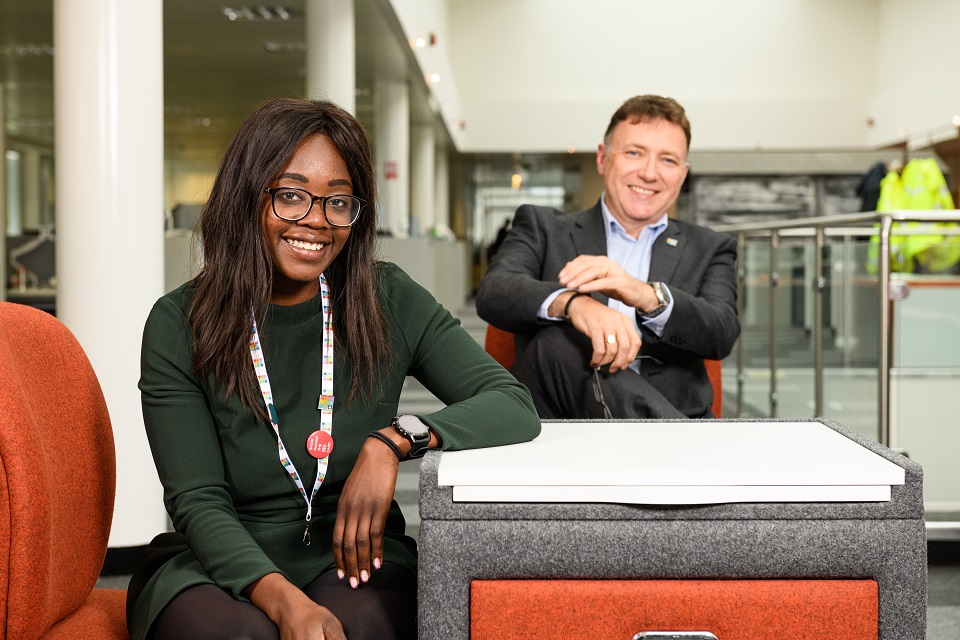
Sadia Samas (left) and Euan Hutton (right)
My name is Sadia Samas. I’m a graduate mechanical engineer working for vents capability at our Warrington Offices and I’ve worked for Sellafield Ltd for almost 2 years.
I reverse mentor Euan Hutton, which is fun. In our first meeting we came to understand quickly that we both see the world based on our experiences. From there we are then able to base our meetings on what is topical, so we talk about what is going on in the world and at Sellafield.
I am most proud of the mentee-mentor relationship Euan and I have built. I think we are both willing to make a few mistakes, be politically incorrect and cross some boundaries. However, it makes our conversations open and honest and I think that’s why it is going so well.
Leadership academy
Case study - Joanna Petrie-Rout and Carol Parkinson
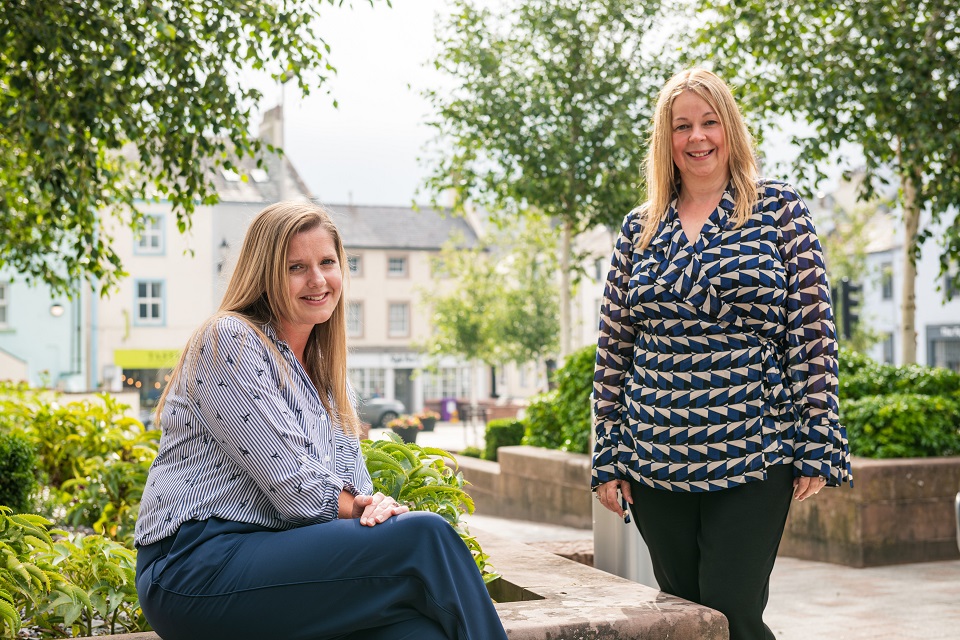
Carol Parkinson (left) and Joanna Petrie-Rout (right)
Our investment in our employees doesn’t stop at the courses and qualifications we support every year. It has also seen us create a Leadership academy, rolling out development for leaders across our organisation.
This year we’ve adapted the academy offer so that it could continue virtually and have worked with colleagues across the NDA businesses to help create and roll out a leadership standard for the group.
I’m Joanna Petrie-Rout and I’ve worked at Sellafield Ltd for 7 years. Today I’m the head of high performance leadership.
In March 2020, we started to develop a leadership standard for Sellafield Ltd. The project was upgraded to include the NDA Group.
We used an inclusive, collaborative approach to ensure as many people as possible were able to co-create a standard that reflects our context and language which is really powerful.
The pandemic gave us the opportunity to pause the delivery of our Leadership Academy to align the content to our manifesto and the leadership standard. We leveraged the new technology of Teams to deliver the programme virtually without losing the experiential elements that make the programme so impactful.
My personal highlight has been seeing a collaborative project like the leadership standard come to life with so much engagement completed virtually; this was a big shift. It has been incredible to see our people embrace the challenges that the pandemic presented and adapt so effectively.
My name is Carol Parkinson and I’m a leadership development manager. I’ve worked at Sellafield for 16 years.
In response to the COVID-19 pandemic we had to not only re-design the academy to align and embody our manifesto but also the leadership standard, to ensure that it supports leaders to embed the leadership standard in everyday leadership moments.
Feedback from the pilot that programme really pulls everything people focused together was great feedback not only for us as a team but our suppliers.
In January 2020 the leadership academy undertook a project review. Pulling together the evidence pack that told the story of the conception of the LE3AD programme as well as the evaluation feedback that delegates had provided really made us reflect on all that we had achieved in the first 12 months of the programme.
It was fantastic to be able to show that we had acted upon feedback from delegates to improve the programme. In August 2020, academy and the LE3AD programme was recognised externally when we won a gold award for Excellence in Blending Working.
This was a fantastic moment and one that we were able to share virtually as a team and with our supply chain partner Lane4 as the announcement was made.
OneLGBT+ network
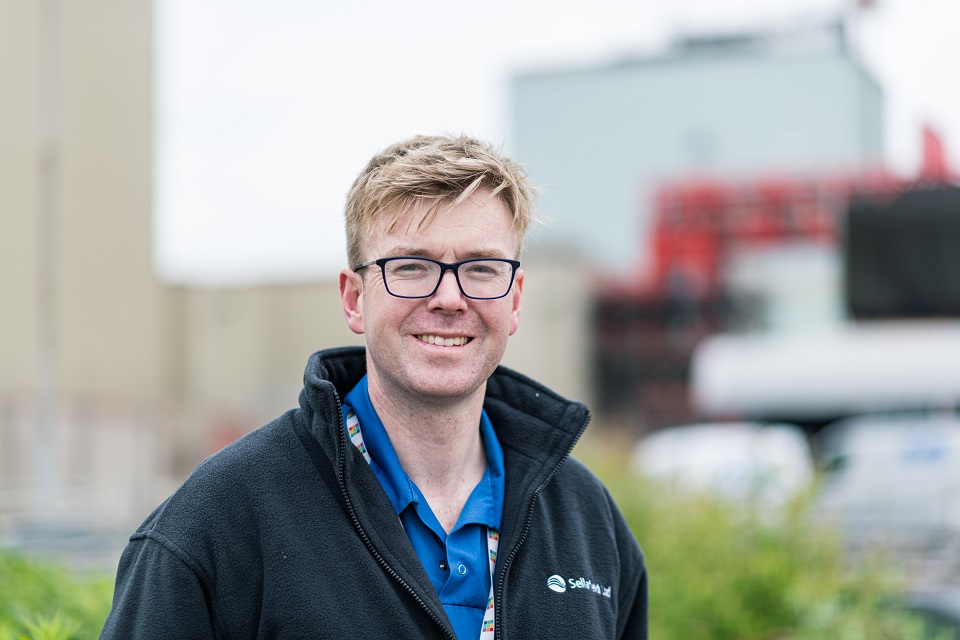
Our employee networks are helping to drive change in our organisation.
My name is Craig Calvin and I’ve worked at Sellafield Ltd for 8 years.
My paid role is operations team leader but I’m also co-chair of the Sellafield Ltd OneLGBT+ network and a change maker for our manifesto.
The oneLGBT+ network started as a small group of us who wanted to work to make sure that Sellafield Ltd was a supportive, inclusive and diverse organisation.
We now have more than 40+ members from across the business, all of whom are advocates for the LGBT+ community.
They’re supported by a growing band of allies, who are also championing our cause. Creating and developing the LGBT+ network was not only the right thing do, it also make business sense.
Worldwide research shows companies that embrace D&I have sustained higher performance than others (anywhere between 21% and 33% higher).
We’ve secured buy-in to our work with business leaders, Human Resources, our diversity committee and other networks. This support is key to our success.
Together we’ve:
- provided strong support to individuals experiencing challenges
- working with Human Resources to develop a LGBT+ improvement plan
- developed line manager guidance
- worked with the other employee networks to provide diversity and inclusion packages for education centres and schools
- engaging and building relationships with external companies to share best practice on developing networks
- developed and executed a high level strategy document
- created a safe place to discuss LGBT+ issues
I’m proud that we’re making a positive difference to peoples’ lives, and hearing our members say that they’re growing in confidence, and stepping outside their comfort zones. This is the stuff that really drives me.
Being able to help someone in a difficult or sensitive situation and receiving thanks from the in individual made me feel really proud. We have done a lot in a small amount of time, but our journey is just beginning.
Apprenticeships
The ambition of our people strategy is to unleash our potential through the power of our people.
We are proud to continue to provide exciting and rewarding careers not only for our existing workforce but also for the next generation of nuclear workers.
Although the pandemic meant we had to do things slightly differently, with remote assessment centres and virtual interviews, we continued to recruit apprentices and graduates into our organisation in 2020/21.
For our apprentices especially, the introduction into the world of work was something that no one before them had experienced.
Case study - Naomi Peers

My name is Naomi Peers and I’m a business administration apprentice. I joined the business in September 2020 and I’m currently on my second 6 month secondment, this time working with the Corporate Affairs team.
It was very unusual to start an apprenticeship and join an organisation in the middle of a pandemic. Normally starting work somewhere includes company and building inductions, face-to-face time getting to know the team – even social things like going out for team lunches. But I was only in the office for 3 weeks and have worked from home since.
I quickly realised though that I had been employed to do a job, not to sit in a certain place. So I set up a desk at home and collected any equipment I needed from the office.
I was always offered all the support and help I needed, having regular meetings with teams and line managers that didn’t just cover work but also my wellbeing.
I think the fact that everyone was in the same boat really helped, but I’m still proud of the way I adapted, coming straight from school to working remotely for a £2 billion business.
I am also proud of the maturity, confidence and independence I have gained throughput my apprenticeship so far and the skills I have already gained.
It’s also been great to see that progress reflected in the feedback from my team members, external customers.
12. Social Impact
Working with our owner, the NDA, we’ve developed a new approach to social impact. It is designed to help us to deliver our mission whilst enabling significant social improvements and economic diversification in those communities closest to our sites.
In 2020/21 we launched that new approach under the banner of Social Impact Multiplied. The name reflects the fact that we can achieve so much more through partnering and collaboration than we can on our own.
Social impact is the effect that our company actions have on people and our community and ultimately, it’s about creating permanent, positive and significant social or economic change through deliberate activities.
Our approach is simple:
Root cause
Targeting our resources to seek long-term solutions.
Co-create
Effective stakeholder and partnership working for collective impact.
Leverage
Actively seeking to use our own investments to leverage further investment from others sustainable investments and interventions help create solutions that endure.
Measurable
Outcomes and impact are reported and independently and externally verified.
And our work is aligned to 5 strategic objectives:
- Thriving communities - Social impact activities sustain and enhance community assets and address community needs
- Resilient economies - Resilient, inclusive and growing local economies creating and securing new opportunities
- Sustainable incomes - Inspiring skills, education and personal development activities improve access to sustainable incomes
- Collective impact - Effective stakeholder and partnership working for collective impact
- Social value chains - Increasing impact, scale and duration of our supply chain activity in support of citizens, communities and our local economies
These objectives, along with the rest of our social impact strategy, are aligned to many of the UN’s sustainability goals.
For the full strategy, visit our website.
The following pages give a high-level summary of our Social Impact Multiplied work in 2020/21 along with the stories of the people who helped make the investments a reality and those who are already benefitting.
This section also includes just a few of the hundreds of our employees who volunteered to help in their local communities during the pandemic. While there isn’t room to feature them all here we do want to say thank you to each and every one of them.
The first major investments announced under Social Impact Multiplied in 2020/21 were:
Transforming West Cumbria
Transforming West Cumbria is a £2.2 million fund to help West Cumbria’s most vulnerable communities. Delivered by Cumbria Community Foundation, it aims to put local people in charge of their own futures by empowering neighbourhoods to create transformational change.
Among the initiatives are:
- a £1.3 million fund for community and voluntary groups
- £660,000 to support families
- £175,000 to fund financial education
- schemes to nurture young entrepreneurs
- and a drive to make community activism the norm for young people
It is made up of 6 programmes:
Bedrock
This will:
- empower leaders of community organisations with skills, resource, and time to invest in business strategy and development
- support businesses to explore new ways of working, including money making, use of digital, collaboration, sharing resource and better management of community assets/premises
- improve governance
- build the ability and future proofing, through staff development, expert volunteer recruitment and clear succession planning
#CanDo
This will:
- raise young people’s aspirations and build their confidence
- provide grants to support social or environmental action projects designed by young people, for the benefit of their communities
Family Wellbeing
This will:
- improve the health and wellbeing of some of the most vulnerable and disadvantaged children and families in West Cumbria
- invite community-based organisations working with disadvantaged children and families to apply for grants of up to £50,000 against the established criteria
- partner with local charitable organisations: West Cumbria Child Poverty Forum and Children’s Social Care and Health Services
Financial Wellbeing
This will:
- improve the financial capability of people on low incomes living in deprived areas of West Cumbria
- promote financial capability via existing community networks and in places where people come together and feel welcome without stigma
- break down the barriers to discussing personal finances, overcome stigma and engage people in a solution based approach
Spark
This will:
- inspire, encourage and nurture new and existing social entrepreneurs
- work with Cumbria Social Enterprise Partnership
This will deliver 3 levels of support:
– Think it - bespoke advice will be delivered in workshops or 1:1s – Try it - support to test out ideas via grant awards of up to £5,000 – Grow it - supported for existing social entrepreneurs to build sustainable financial models via grant awards and/or repayable grant loans of up to £15,000
Positive Disruptors
This will:
- provide young people (10–25 years) from disadvantaged backgrounds in West Cumbria with the opportunity to have their ideas and ambitions heard and the potential to have them realised
- challenge young people to think creatively and in more enterprising ways
- empower young people to ‘positively disrupt’ the status quo and to be heard
- support young people to test out their enterprising ideas
- break down the barriers for aspiring young entrepreneurs, by developing an enterprising culture based on encouragement and support
Benefitting from Bedrock
Case study - Tracey Parker

The Allerdale Disability Association based at Moorside, Workington, was one of the first beneficiaries of the Bedrock programme within Transforming West Cumbria.
I’m Tracey Parker and I’m the manager of the Allerdale Disability Association at Moorclose.
Thanks to the Bedrock Basics project we’ve received advice, support, tailored funding searches and access to first class training that would not have been financially viable for our organisation at this time.
With that support we’ve been able to use the funding search information to secure funds to deliver our services until March 2022.
Not only was the information provided timely and specific to our needs, but the opportunity to seek advice and feedback on an application prior to submission has been invaluable.
In addition we are taking part in 2 different training packages that are helping us to get to grips with business planning and all that it encompasses and how to collect and report on the impact we make to the community, which in the past we have struggled to demonstrate effectively.
I believe this will strengthen the capacity, impact and sustainability of Allerdale Disability Association moving forwards.
The thing we are most proud of over the last 6 months is that we have been able to continue to support our beneficiaries throughout these most challenging of times and have also been able to learn, plan and look forward to the future.
The Edge
The Edge is a multi-million-pound programme to make Whitehaven the tourism capital of the Cumbrian coastline and is being funded by us and the Coastal Communities Fund.
It will feature accommodation, storage facilities, and flexible activity spaces and will become a spectacular starting point for the world-famous C2C cycle route.
Seabins
Our commitment to sustainability stretches beyond our site and offices. Through Social Impact Multiplied we’re also helping to make environment projects a reality – helping to make changes that will benefit the environment today and educate young people to make better environmental choices tomorrow.
This year we invested in a cutting-edge filtration system that will be installed into the harbour, putting the town on a par with Dubai and Sydney.
Developed and delivered by the Whitehaven Harbour Youth Project, our £100,000 investment has helped to fund a filtration system of floating ‘Seabins’.
The Seabins filter and remove plastics, microplastics and oil from the water, creating a cleaner and safer environment for water sports and marine wildlife.
By 2023, Whitehaven Marina will be the first in the world to boast 7 Seabins, putting the town ahead of Dubai, which has 6, and Sydney, which has 2. Only 4 other places in the UK have them.
The environmental education programme will involve local schools and other community groups in the area and provide education about plastic pollution and its impact on the local and global environment.
The Eagle has landed
In previous financial years we have, through collaboration with NDA, BEC and Copeland Borough Council, invested to turn a once derelict bus station in Whitehaven into a hub for creative and digital start-ups.
This year the team worked hard to add another facility to the bus station, partnering with Barclays Bank to create the first Eagle Lab outside of a major conurbation.
It opened its doors in May this year and offers co-working, office and meeting space, plus a space where entrepreneurs, individuals and businesses can access innovative tools, curated events, and the right network to innovate.
Entrepreneurs can also access banking services, business expertise, mentoring and coaching,Tracey West was part of the team who made it happen.

My name is Tracey West and I’m a social impact manager. I’ve worked for Sellafield Ltd for 13 years.
I have worked with BEC for the past 4 years developing the business cases and securing funding for the £8.2 million development of the Bus Station.
We not only managed to transform a derelict building that was left unused for 20 years, but we managed to develop a partnership with Barclays Eagle Lab to offer support to businesses and entrepreneurs from the Bus Station.
This is a project that will have an impact for years to come, leading to a more resilient economy, creating many opportunities for people and exciting developments along the way.
It has been a fantastic project to be involved in and one I am really proud of. I have watched the site develop over the last 2 years into what it is today, something I’m proud to put my name to.
The transformation to the gateway into Whitehaven is significant and it is now a place that everyone can enjoy. I have worked with a great team throughout the project and the team continues to evolve with exciting times ahead attracting businesses, entrepreneur’s, making new connections and coming up with new ideas.
Warrington Youth Zone
Case study - Pauline Deans

While the focus of our investments is in the communities closest to the Sellafield site, we do also invest in Warrington. This year that included a project to help build a new state-of-the-art youth zone.
Once open, it will provide young people across the town with a safe and inspiring place to spend leisure time away from the pressures of home and school.
The youth zone will ensure that every young person in Warrington, regardless of their circumstance or background, can access first-rate facilities alongside expert mentoring and employability programmes; levelling the playing field and tackling specific issues that might otherwise hold back our young people.
Pauline Deans helped to make the project a reality.
I’m Pauline Deans. I’ve worked for Sellafield Ltd for nearly 36 years and I’m a community liaison officer.
Warrington has a marked difference in prosperity and quality of life in the town with a number of neighbourhoods being among the most deprived in the UK.
This project supports our Social Impact programme’s Thriving Communities objective, by addressing community need for high quality youth provision within our town, addressing mental health, obesity, health and wellbeing and our Sustainable Incomes objective of providing employability skills and personal development.
I am really proud to be part of creating a facility that will take youth provision to a new level in Warrington and provide our young people with a healthier and happier future.
Help, when it was needed most
During the pandemic we were proud to play our part in the response and immediate recovery efforts led by community leaders, charities and community organisations.
We invested at a corporate level and, with the support of the NDA, supported our employees who wanted to volunteer during work time.
Our corporate support included:
- £200,000 donation to buy PPE for frontline health workers
- £10,000 donation to the Mirehouse Residents Association to buy food parcels and meals for the vulnerable
- our map teams helped Cumbria County Council develop an app to support the most vulnerable
- donating more than 650 recycled laptops to local schools
Case study - Craig Redhead
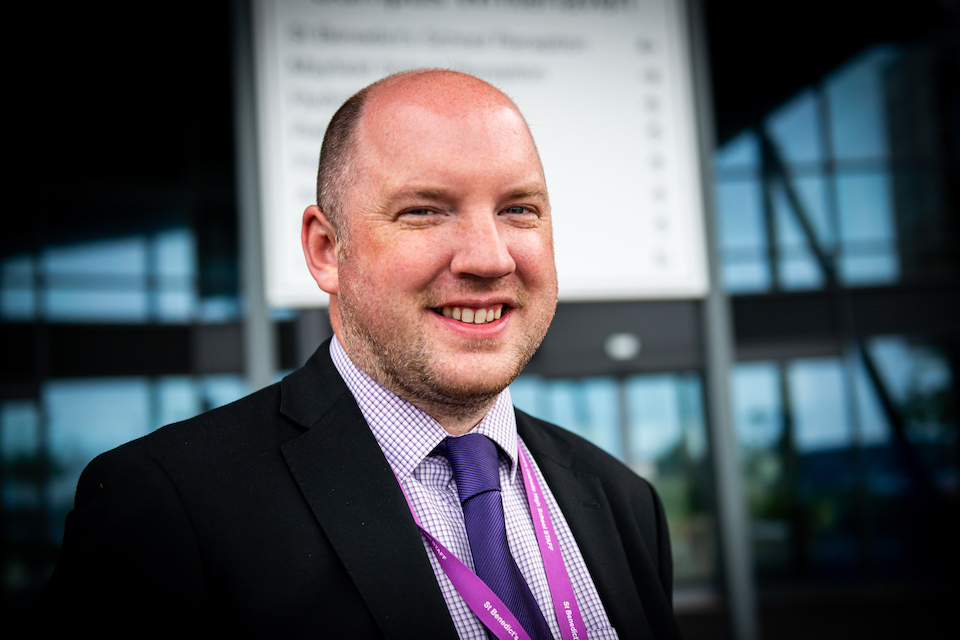
My name is Craig Redhead and I’m an assistant headteacher St Benedict’s School, Whitehaven.
The laptops donated by Sellafield Ltd have been a great addition to our school.
We have used the laptops in a range of different circumstances over the last few months, particularly as the school has adapted to the changing needs of the COVID-19 pandemic.
We have placed a bank of the donated laptops in a mobile caddy so that students or members of staff can access them easily. They have been used by class sets of students to complete assessments, research and other on-line activities.
Two of the benefits of the laptops have been their portability and ability to be used via Wi-Fi. These features have enabled us to use the laptops in a range of different situations.
The laptops have a good technical specification, which has allowed us to install specialist software, facilitating demanding technical modelling software to be used.
This has been particularly useful for subject such as engineering. During the remote teaching period in the last lockdown, teachers were able to use the laptops to deliver live teaching lessons to their students.
In addition to their portability, the laptops had webcams and microphones thus enabling students working at home to see their teachers faces making the home learning experience a little more natural.
We have deployed some of the laptops for use in the 6th Form. Students are able to ‘book out’ laptops for use during the day, which has been a benefit, particularly for students during their private study periods.
The advantages provided by the laptops as opposite to the desktop PCs have made life easier for both students and staff.
Our employees also stepped up. They trained so that they could help operate Nightingale hospitals, manned community help lines, collected prescriptions and delivered food and meals to their neighbours.
Here are just a few of their stories.
Pride of Sellafield
Case study - Shona Cunningham
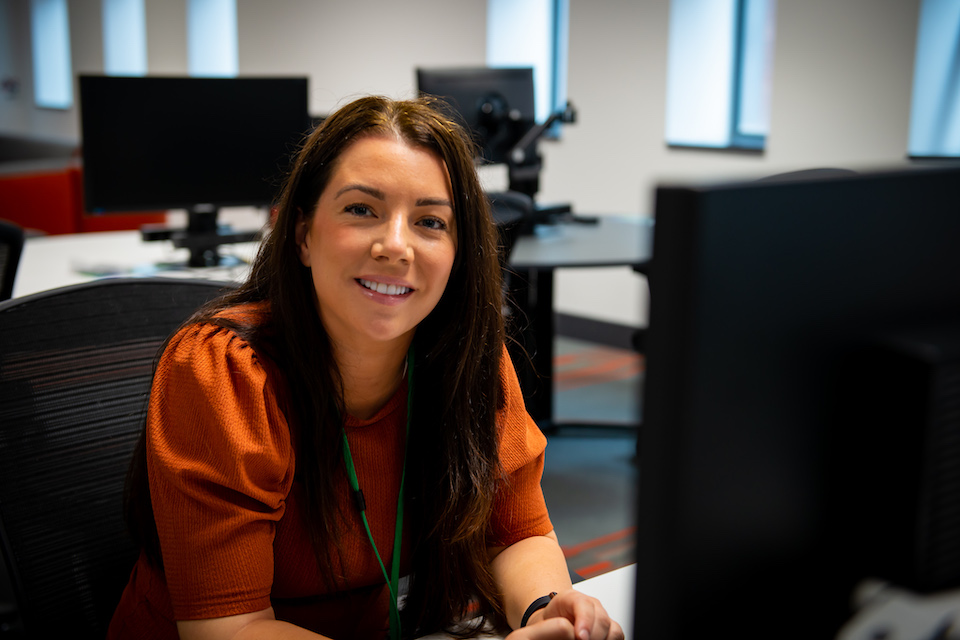
I’m Shona Cunningham. I started working for Sellafield Ltd in 2013 so have been here just over eight years. I work in the business management team in project delivery and, like loads of other employees, I volunteered during COVID-19.
I was nominated for a Pride of Britain award by the general public for my ideas for fundraising. One idea I had was to fundraise to help pay nurses’ registration fees, and another was to create care packages for NHS workers and key workers supporting the coronavirus pandemic.
The Cumbrian public rallied round supporting my initiative donating their fundraising efforts and in total over £30,000 was raised, 170 nurses’s registration fees were paid, and around 400 care packages were delivered round Cumbria.
I’m really proud to have been part of the community’s response to the pandemic and of inspiring others with my initiatives. I had numerous messages from people around the country asking if they could copy my initiative to pay the nurses’ registration fees.
Manning emergency phonelines
Case study - Caroline Easdon
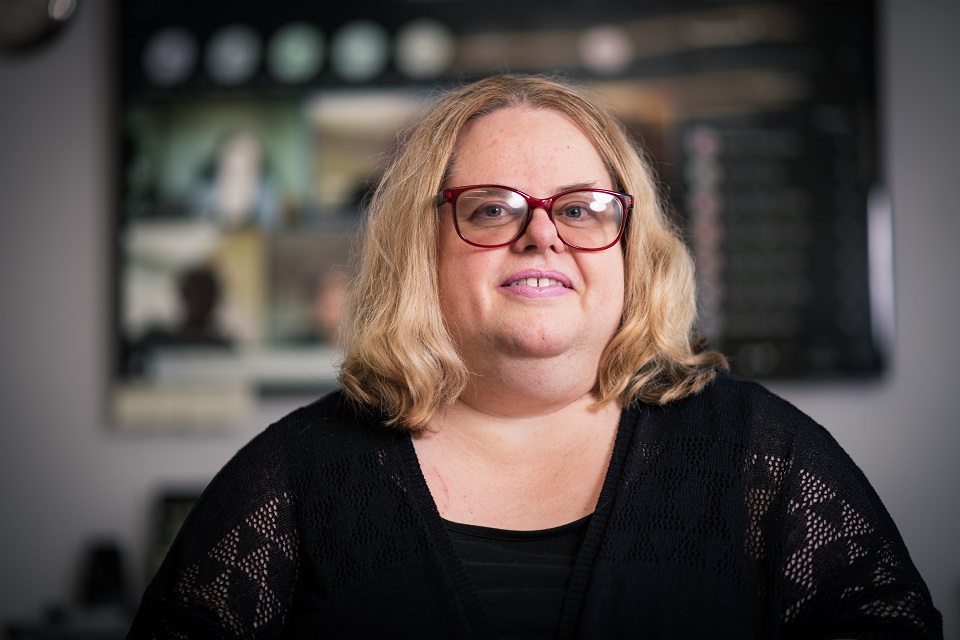
In the earliest days of the pandemic the huge demand for information and help was managed through quickly constructed emergency helplines. And our employees were ready to answer the call.
My name is Caroline Easdon and I’m a corporate visits planner. I’ve worked at Sellafield for 14 years.
I worked on the Cumbria County Council Emergency covid number helpline switchboard answering calls from all over Cumbria.
The worries people had were mainly about how they would get food and medicine but we had other queries too like people concerned about the mental health and wellbeing of their friends or relatives, how to get a new fridge in lockdown and people stranded in the country on honeymoon.
I answered the calls in something like a triage system, prioritising queries (where people had less than 7 days of food, needed medication asap, or had a friend or relative who hadn’t been seen in a few days) and recording them so that coordinators in the caller’s local area could pick up the referrals and make sure they got the help they needed. I also booked bulk medication collection and deliveries for the pharmacies.
We had a lot of queries from elderly people who had no relatives living close by and who hadn’t spoken to anyone in a long time. I’m proud that I was not only able to help them, but that I took the time to really listen and talk with them.
Most calls were quick, but I had one lady who was on the phone for almost an hour. She had been embarrassed about having to ring and ask for help, but that’s what we were there for. By the end of the call I’d heard about the fascinating life she had led, and she thanked me for taking the time to listen.
The whole volunteering experience made me very proud to be Cumbrian and to be part of the process.
Scrub Hub
Case study - Claire Riley

Claire Riley (left) and Eleanor Billson (right)
Many employees took to their kitchen tables and garages to make 3D printed PPE for health care workers.
For one group, their endeavour would quickly grow from one person to an army of sewers, and bag them the CEO Award at our annual business awards.
I’m Claire Riley and I’m a business change manager. I joined Sellafield Ltd as an apprentice instrument mechanic back in 1992 so have been with the Company for almost 29 years.
I started the Scrub Hub on the evening of Good Friday in response to a social media post from Lowther Medical. They needed people who could make scrubs. I offered to help and set up a Facebook Group and, by the end of the Easter weekend, almost 450 people had signed up to help.
Two of the first people to sign up were Eleanor Billson and Annabelle Vile, both from Sellafield Ltd. I’d worked with them both before and knew the wealth of experience and drive they could bring so asked them if they would help me by taking up key roles.
As more doctor surgeries and care homes came forward to ask for help it became clear that I needed a way to collate and sort all the requests as everywhere needed different quantities and sizes, so on Easter Saturday I created a website.
The website enabled the order information to be exported and managed. The demand from volunteers for information on how they could help was almost overwhelming with 100’s of people messaging asking lots of questions in the first couple of days.
To manage the flow of information Eleanor set up a structure of sub teams each covering a different geographical area.
This structure was invaluable when it came time to distribute materials and collect finished scrubs.
Annabelle took the lead on fundraising and publicity, raising £26,000 to buy the materials we needed. By the end of our manufacturing phase over 2600 sets of scrubs and 10,000+ accessories had been made and distributed.
I am proud of how quickly we were able to create a support infrastructure to enable over 700 volunteers to work together. Having a shared purpose and human contact helped us all stay healthy and positive.
We all need allies
Case study - Colin Bell
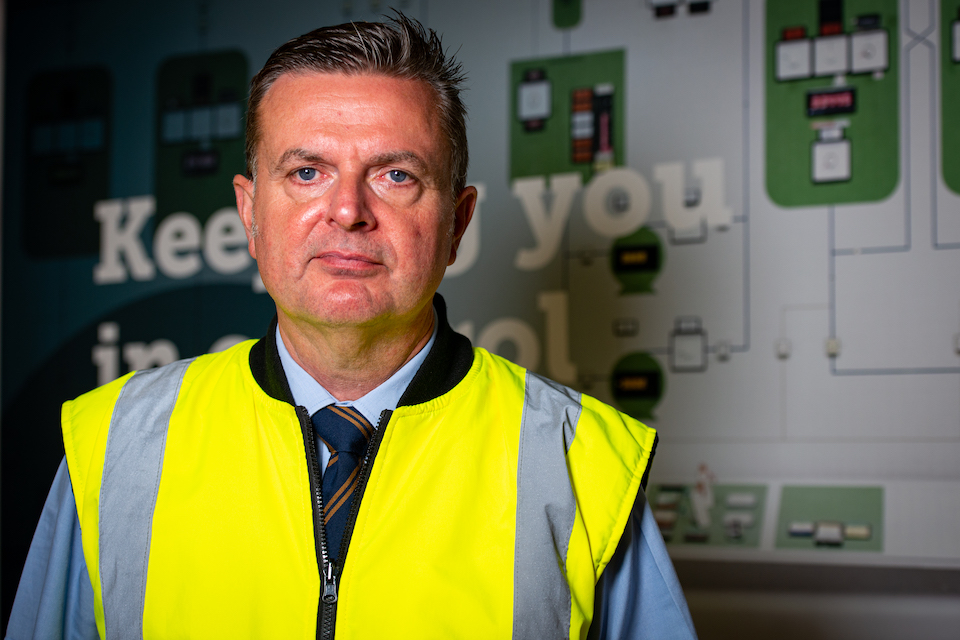
I’m Colin Bell. I’m currently a control systems manager, within specialist equipment services in engineering and maintenance. I have worked for Sellafield for 40 years.
Winning the ‘ally of the year’ award from Women in Nuclear UK is testament to the work that the group members have put in over the last 18 months, because from my perspective the award is for the group, not just me.
Being a part of the group has been a tremendous experience, and if I have helped in a small way to help provide an environment for women and men to develop equally, then I am delighted.
I have seen the improved confidence and renewed energy and aspiration/desire from the team members, and that fills me with pride.
I’m big on developing the people within our organisation and trying to help them within their careers.
Helping form the women in control systems group is something I am very proud of, and then to see some of the members go on and take the opportunities that the group is providing is truly inspirational, seeing them grow in confidence and re-invigorate their careers is very rewarding.
I received a personal thankyou e-mail from one of the group members. I had a tear in my eye when I read it. It meant so much.
Menopause network
Case study - Barbara Scrugham

My name is Barbara Scrugham and I’m a conduct compliance manager.
I’ve worked for Sellafield Ltd for 24 years and I’m one of the founders of the Sellafield Menopause Action and Support Group.
This year we organised a virtual menopause event, a first for us. It was held in celebration of the International World Menopause Day to showcase the work of the group in helping to make menopause an inclusive topic at Sellafield by raising awareness and providing guidance, support and advice to those who need it.
Alison Strafford and I first recognised that there was nothing at Sellafield Ltd or externally to support menopause in the workplace way back in January 2014.
Today we have our EDI Hub, menopause cafes and drop-in centres, menopause workshops for women and awareness briefing for all staff, and menopause in the workplace workshops for line managers.
Of course, we haven’t done all this work on our own, we have a fantastic team of passionate people in our steering group, who have supported us.
I’m proud of the difference we’re making. It’s amazing to receive positive feedback from employees who have personally benefited from the work of the group in helping them manage their menopause transition, so they continue to thrive rather than survive at work and home.

